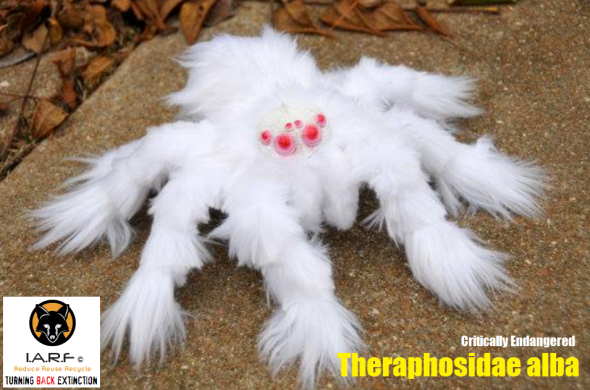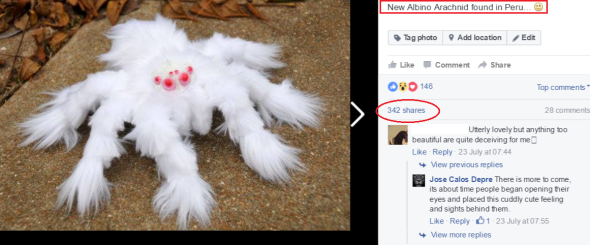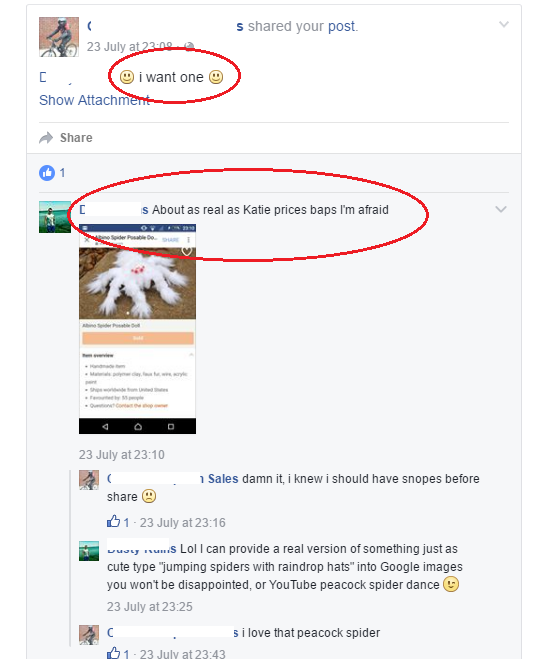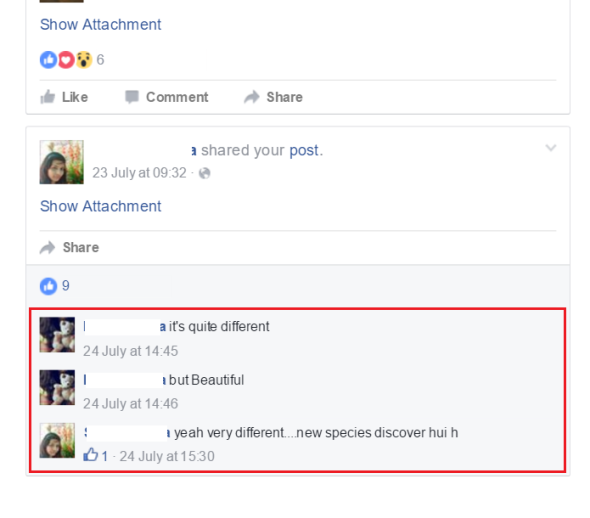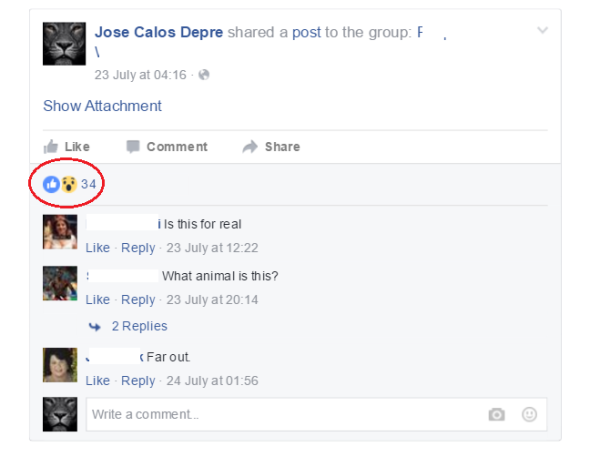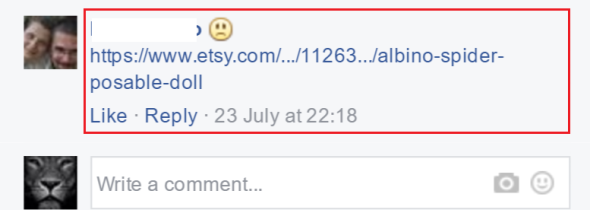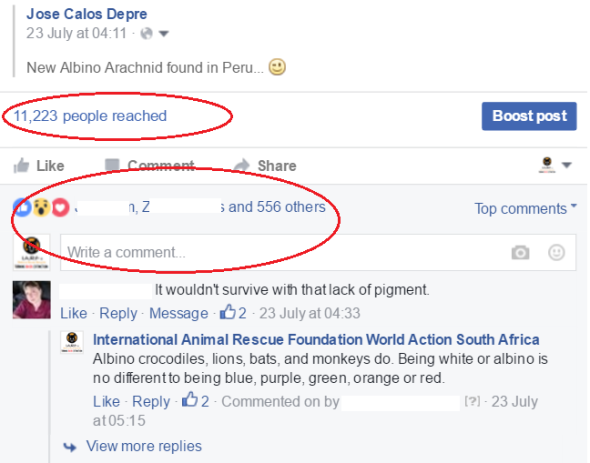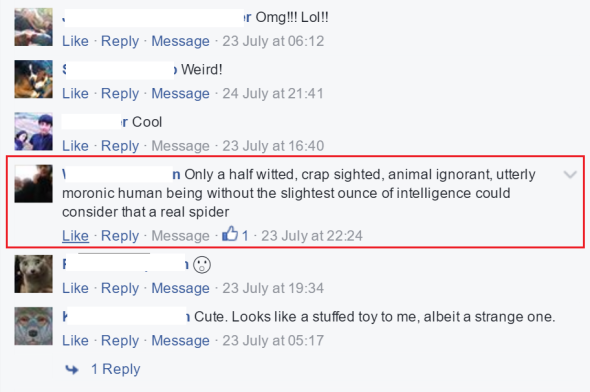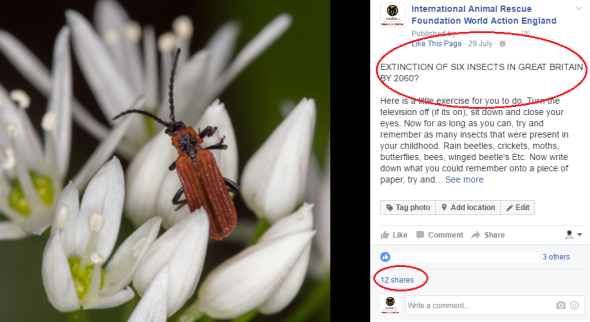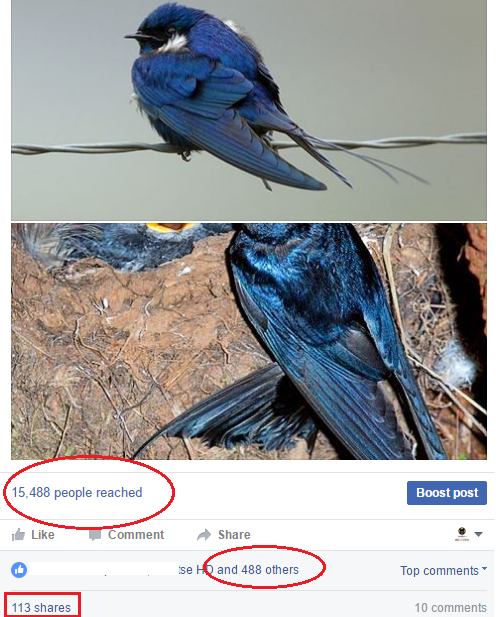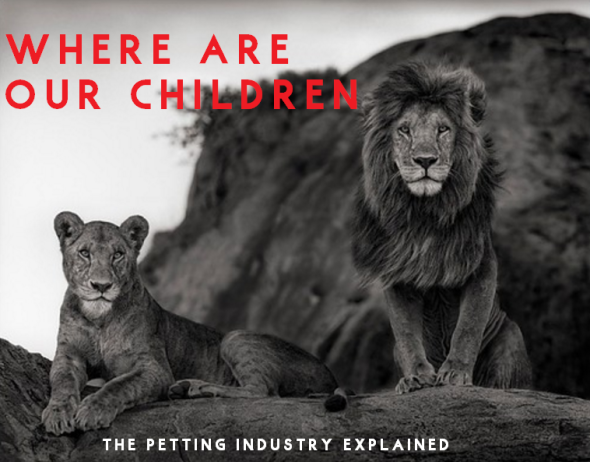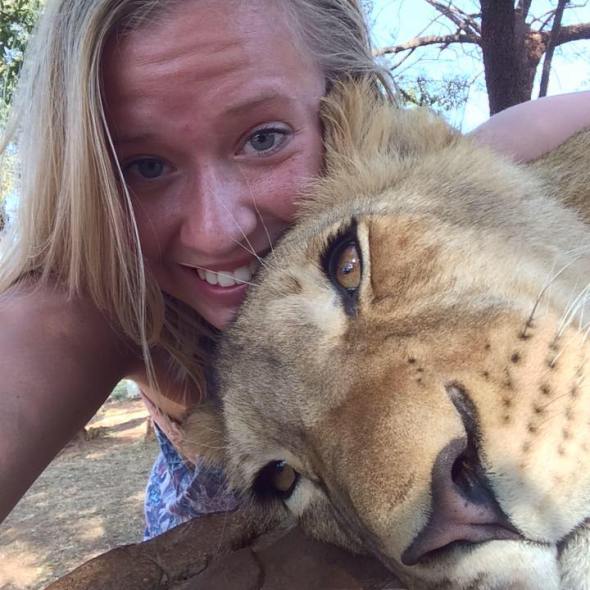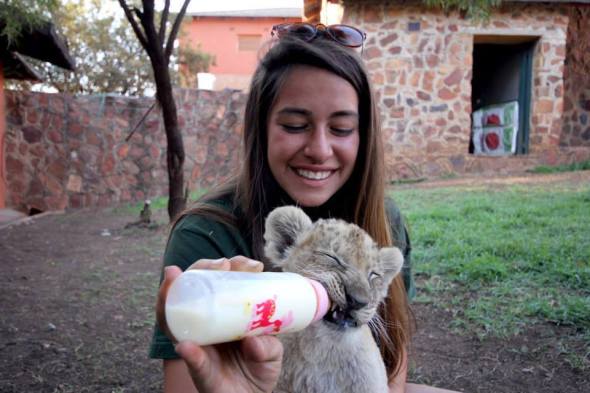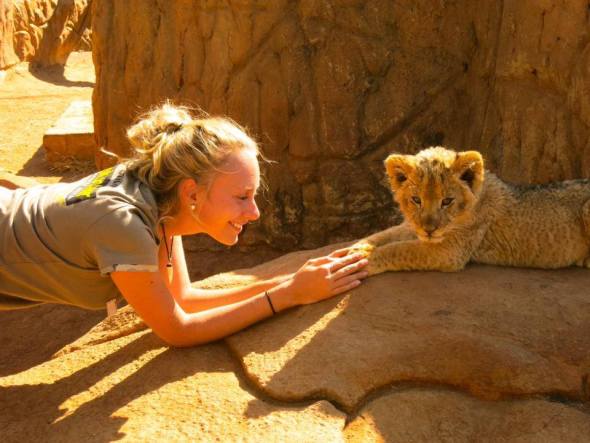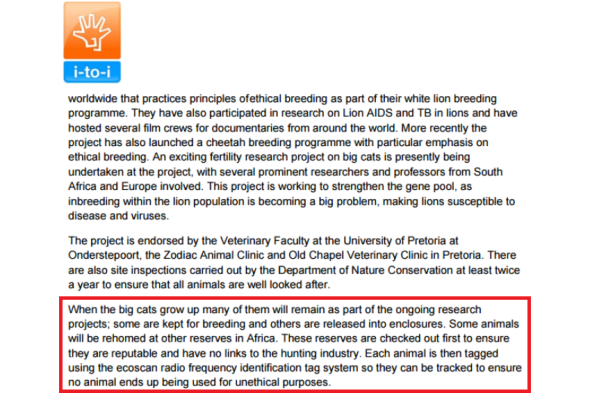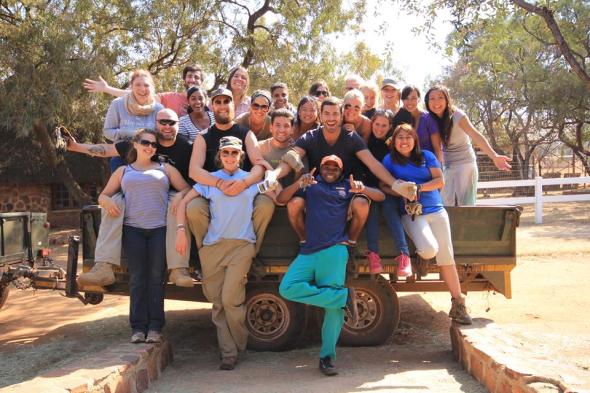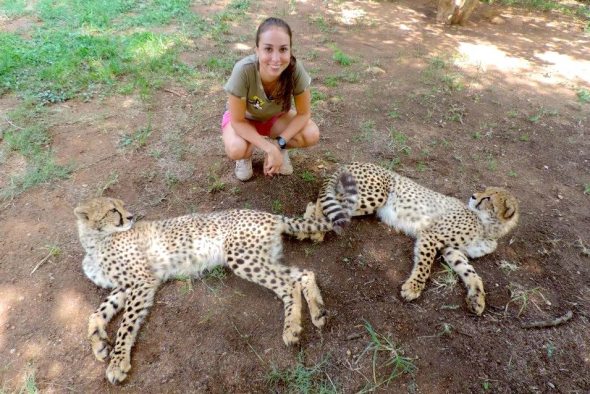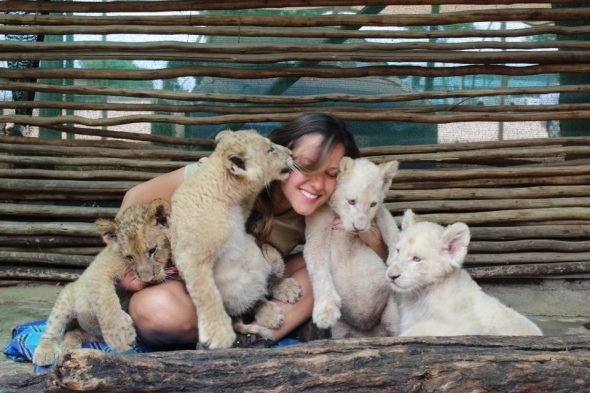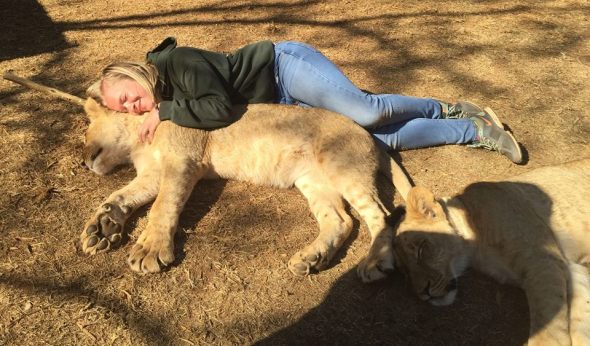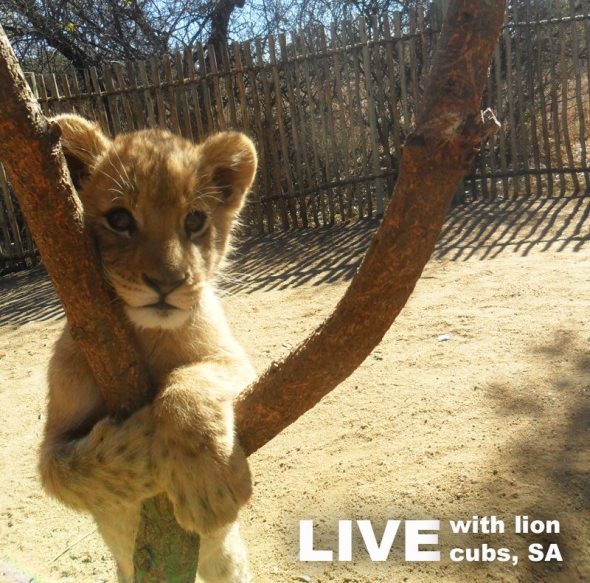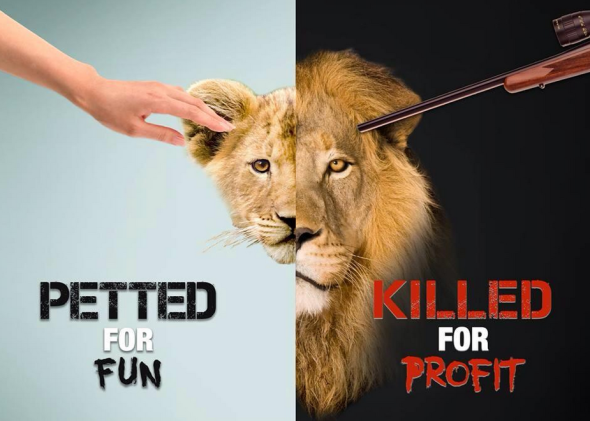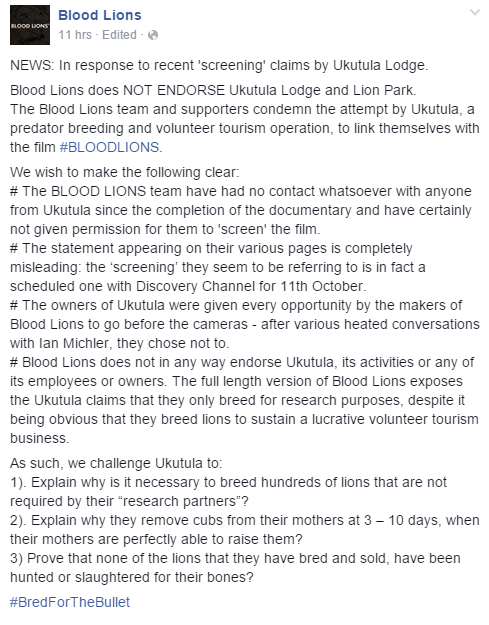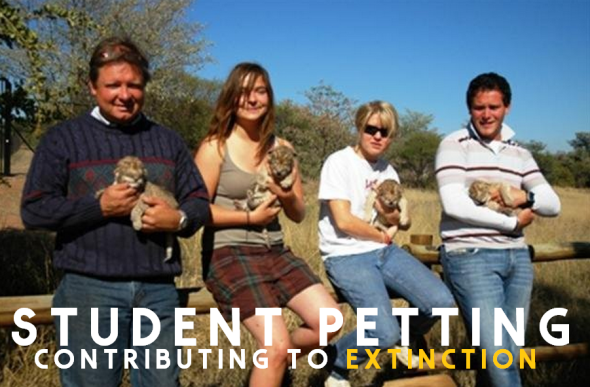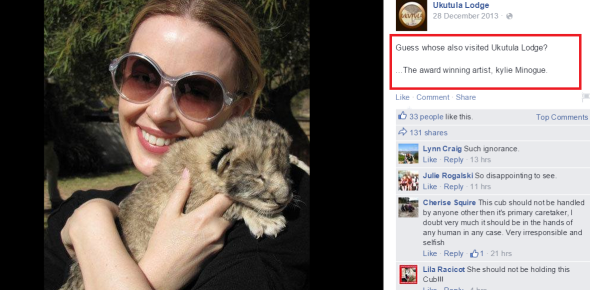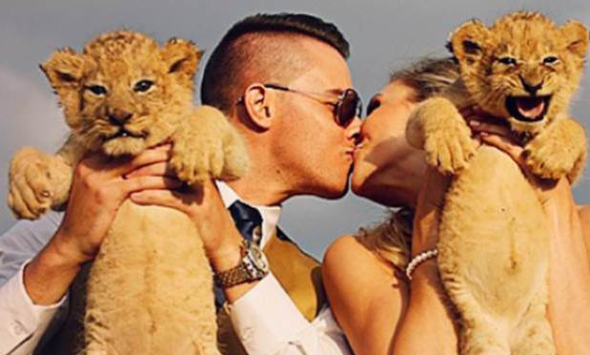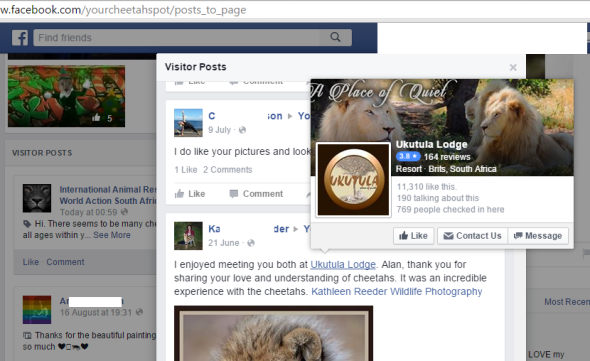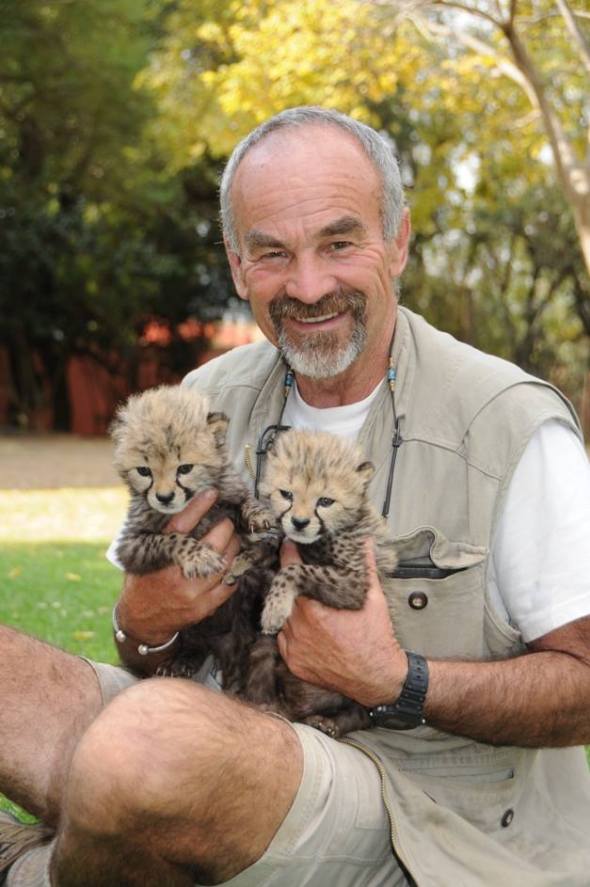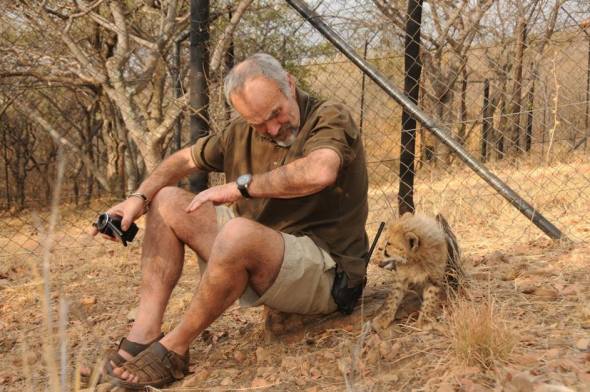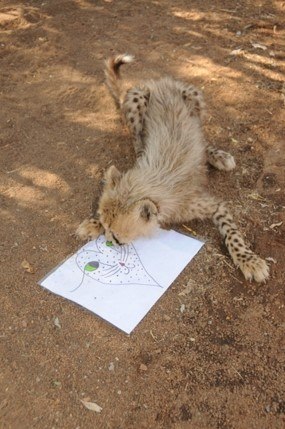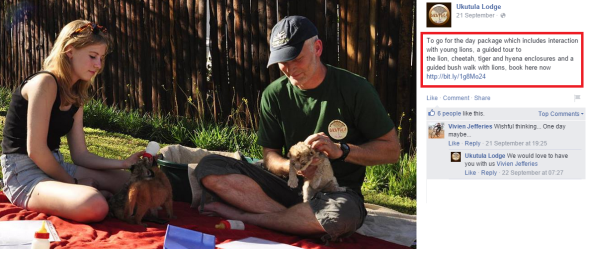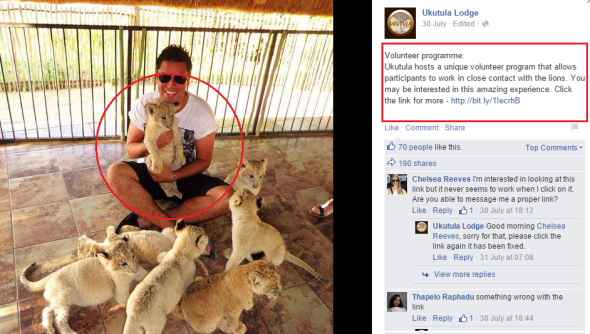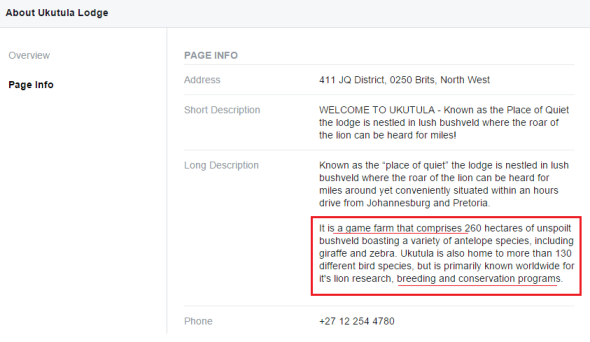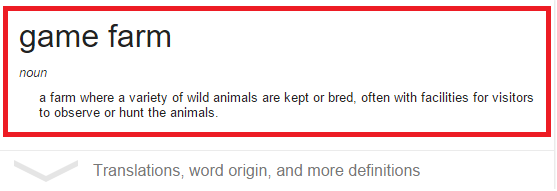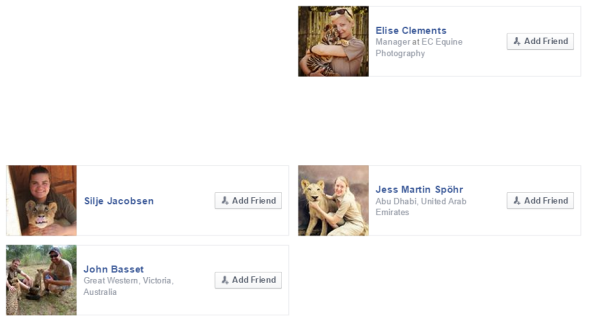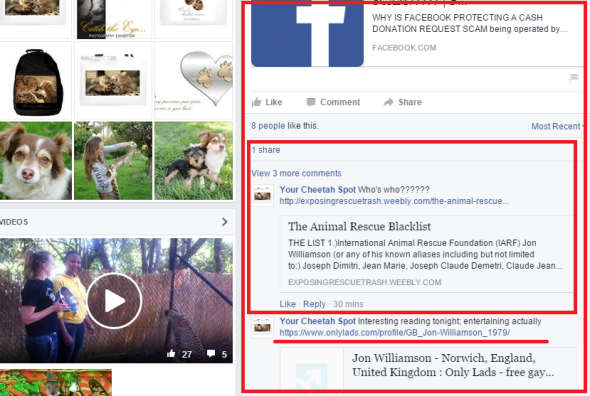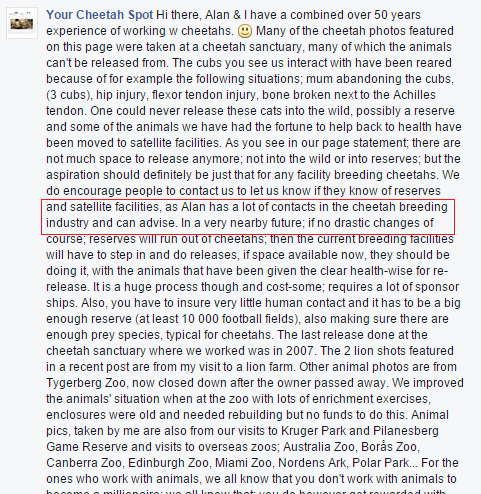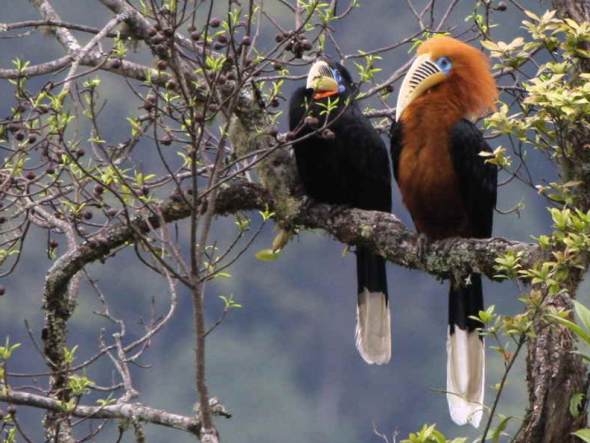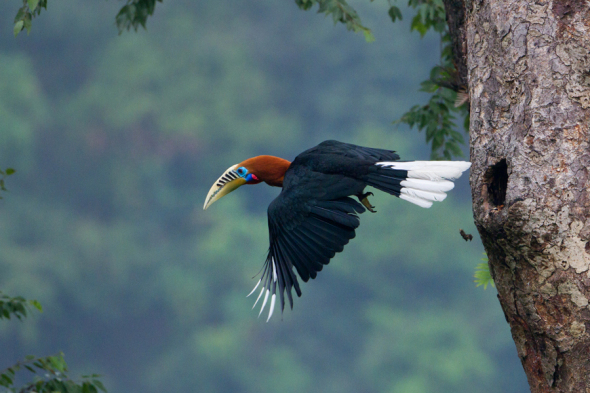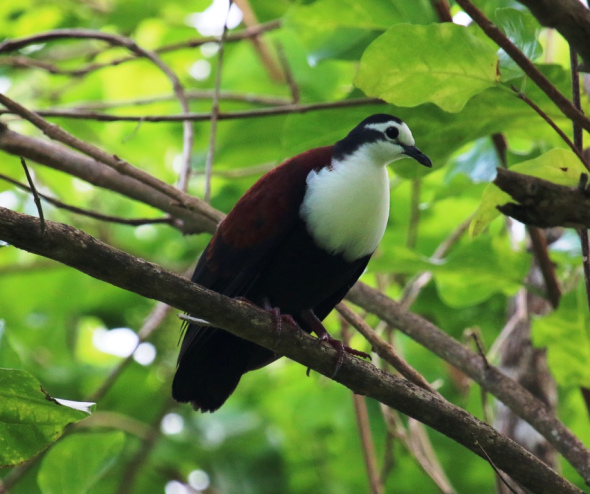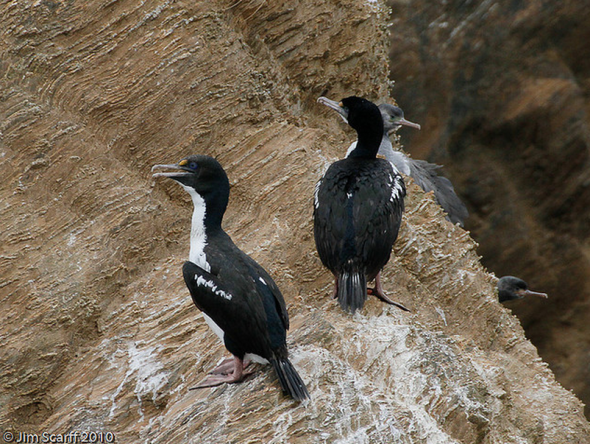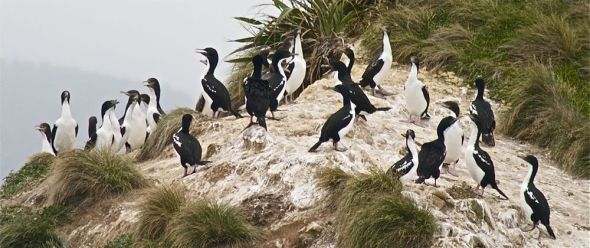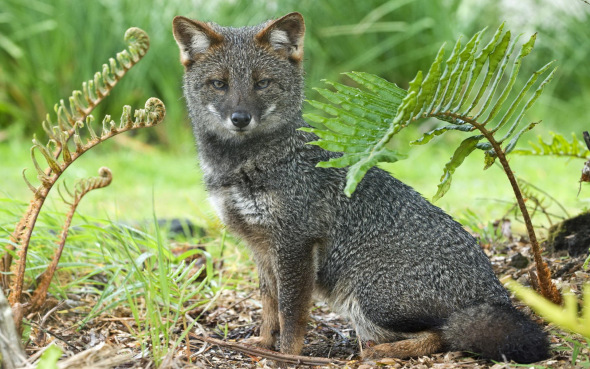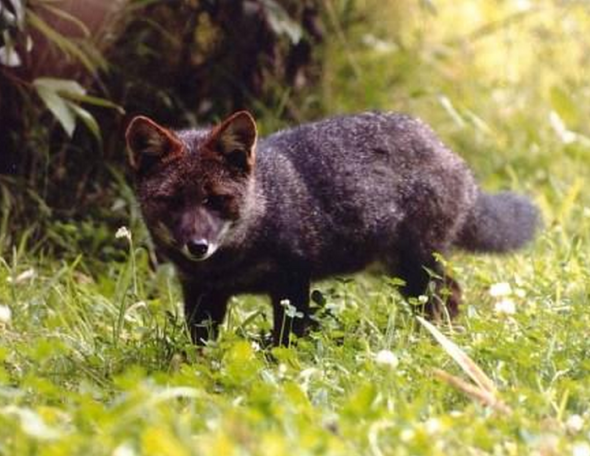WHY IS FLORIDA LOSING SO MANY FISH?


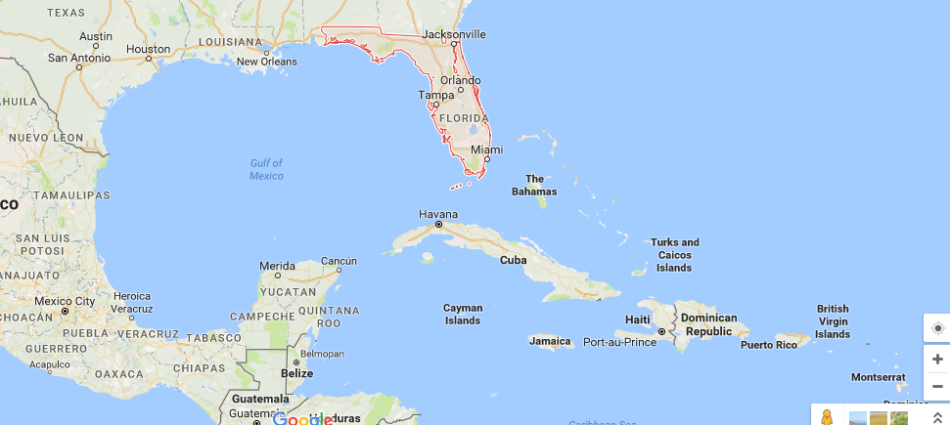
Endangered Species Friday | Bubalus mindorensis | Asia’s Next Extinction!
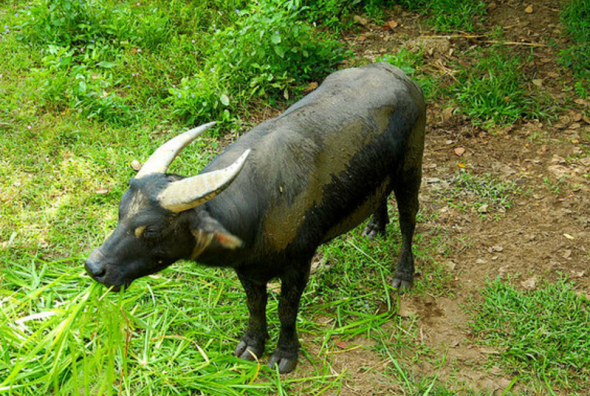
Endangered Species Friday | Bubalus mindorensis
This Friday’s (ESP) Endangered Species Post, I’m touching on a very undocumented species of buffalo that is so endangered - its extremely likely the species will go extinct within the next ten years maximum. (Photographer unidentified).
Listed as (critically endangered) the species was primarily identified back in 1888 by French born Dr Pierre Marie Heude (25 June 1836 – 3 January 1902) whom was a French Jesuit missionary and zoologist. Born at Fougères in the Department of Ille-et-Vilaine, Heude became a Jesuit in 1856 and was ordained to the priesthood in 1867. He went to China in 1868. During the following years, he devoted all his time and energy to the studies of the natural history of Eastern Asia, traveling widely in China and other parts of Eastern Asia.
Endemic to the Philippines B. mindorensis first came to the attention of environmentalists when conservationists began studying the Mindoro Water Buffalo in the early 1940’s of which they found insufficient data relating to the species. Unfortunately from 1986-1996 the species was then suddenly re-listed as (endangered).
Yet the Tamaraw had been known to overseas and native conservation scientists for over THIRTY YEARS of which today we’re now seeing a possible new extinction occurring within the Philippines. How is this possible, when scientists knew about the status of the species, why hasn’t a single zoo removed small populations to house in protective breeding captivity for later reintroduction into the same habitat, or new pastures?
Meanwhile from the year 2000 to 2008 the species was again (re-listed from endangered to critically endangered). Today the Tamaraw is now bordering complete extinction within the wild, and from what we know there is ‘possibly’ no protective captivity projects anywhere around the globe to preserve the species for future reintroduction in the wild. We do hope that we’re wrong?
From what we know based on the last census from 2013 (three years ago) there was noted within the wild only 105 mature individuals remaining. This equates to exactly 105-210 mature individuals (estimate). Within the past three years its very likely we have probably lost half of the remaining populations known, which could mean there is only 52-205 mature individuals remaining within the wild to date.
The species is not known to be fragmented, however populations are still declining. The major threat was once identified as hunting, although ‘allegedly’ isn’t known to be a threat now?. As a scientist and environmental crime CEO I find this very difficult to comprehend, due to the amount of horned ungulates which are being located throughout South East Asia. I must state though: my environmental crimes officers as yet haven’t located any Tamaraw horns or trophy heads.
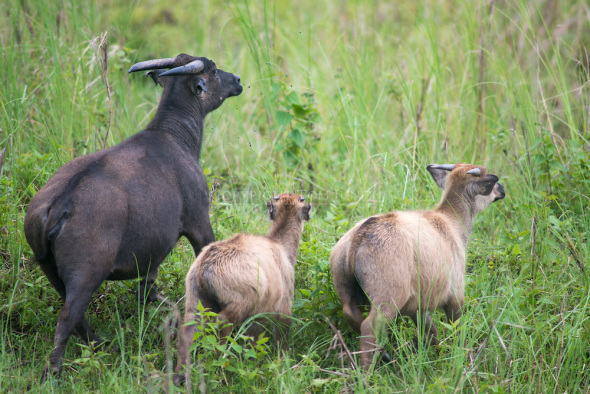
Image: Tamaraw. Credits: Ruisu Fang.
Formerly, Tamaraw were found across the whole of Mindoro from sea level to the high peaks (to over 1,800 m), inhabiting open grassland or forest glades, thick bamboo-jungle, marshy river valleys, and low to mid-elevation forests. The species is currently confined to a few remote areas over 200 m, and is most often recorded in secondary forest and mixed forest/grassland.
Tamaraw are largely solitary, although females occur with offspring. Males and females occasionally associate temporarily throughout the year, which is similar to other bovines species, such as African buffalo, banteng and gaur. The solitary nature of the species is probably an adaptation to forest habitats, where large groups would prove to be a hindrance. Tamaraw feed primarily on grasses, as well as young bamboo shoots, in open grasslands, resting within tall grasses or dense forest. Although formerly diurnal, Tamaraw have become largely nocturnal due to human encroachment and disturbance.
“WE’RE LOSING THEM, AND FAST”
I do find it quite disheartening to know that the Philippines “national animal symbol” isn’t really being preserved or even protected from nearing complete extinction, although there are some projects out there that are helping to save the species from extinction, the problem is of course, as usual, funding!. One would think that a country that’s so wealthy, and a country that has introduced so many animal, wildlife and environmental laws would at least be fighting to protect the tamaraw. From what I have read and heard from the locals - they are trying their utmost hardest, unfortunately not everyone thinks the same as many kind Filipinos.
THREATS
The main current threat to the Tamaraw is habitat loss due to farming by resettled and local people, with a high human population growth rates in and around its remaining habitat. In some areas, fires set for agriculture are a threat to the species’ habitat. Cattle ranching and farming activities pose a number of threats, including the risk of diseases spreading to the Tamaraw from livestock and burning of pastures leading to a reduced number of palatable grass species.
Historically, Tamaraw were hunted for both subsistence and sport, which led to a period of drastic decline in numbers of individuals and populations. Hunting was carefully regulated prior to World War II, but since then a growing human population, logging operations, ranching, and widespread availability of firearms on Mindoro have caused a dramatic decline in numbers.
Since the 1980s, sport hunting has reduced due to a decline in the Tamaraw population, closure of nearby ranches, and more intensive patrolling and awareness activities since the establishment of the protected area. International trade in this species or its derivatives has not been reported. Although protected by law, the illegal capture and killing of this species continues.
While its currently “illegal to poach or hunt” the species “we believe some are still being poached within the Philippines to provide horns to both China and Viet Nam”. As yet there is NO EVIDENCE to back these claims up, however I.A.R.F.A environmental crimes officers have located in Viet Nam a lot of ‘counterfeit Rhinoceros horn’, which when analysed, has proven to us the horn[s] most certainly aren’t from rhinos, but from a buffalo species. So this area of the counterfeit rhino horn trade still needs intensive investigation.
The current plight of the tamaraw is not looking good, and from our own investigations and third party environmental investigations relating to the species - extinction is very likely to occur in around five to ten years (if that).
“THE TAMARAW IS ASIA’S NEXT EXTINCTION”
Thank you for reading.
Dr Jose Carlos Depre. PhD. MEnvSc. BSc(Hons) Botany, PhD(NeuroSci) D.V.M.
Environmental, Botanical & Human Scientist.
Where Are Our Children? Brutality of South Africa’s Past.
WHERE ARE OUR CHILDREN?
Introduction:
Despite our best efforts to educate and push awareness into the public domain in relation to big cat hunting and the petting industry in South Africa and neighboring countries. We have uncovered a rather large core of dedicated students and volunteers from America, Canada, eastern and northern Europe and South America that still defy the basic knowledge made public, that what they are practicing is harming both captive and non-captive felids. These students actions are contributing to the spread of disease and is supporting abuse no end. Furthermore International Animal Rescue Foundation Africa’s Environmental Investigations Unit has unearthed countless British travel agencies, South African universities and even veterinary establishments that support the petting industry. (Image credit Nick Brandt)
The Petting Industry Explained:
Since the release of the Blood Lions documentary one would have thought that students whom continue to visit these seedy and corrupt lodges, parks and alleged reserves, would have taken note that their behavior is more a hindrance to conservation and wildlife alike, rather than supporting ethical conservation itself. Unfortunately this ‘hardcore group’ of mostly disrespectful, uneducated students and volunteers have simply brushed that advice and education aside. The petting and hunting industry within South Africa is increasing in size, despite vast reams of data and evidence made public that clearly shows these industries have no value to conservation whatsoever.
International Animal Rescue Foundation Africa made it quite clear that we would expose students, volunteers and tourists that defy basic conservation education, while participating in unethical and abusive non-conservation tourism. Trainee veterinary technicians, private vets, school leavers, trainee zoologists, backpackers, doctors, judges down to missionaries, pilots and even celebrities are all contributing to the extinction of our African Lion, Cheetah, Leopard and even non-endemic Tigers. While we are aware that some infant and adult cats have been rescued via the many lodges, parks and farms within South Africa, and that other animals simply cannot be released into a reserve, the fact of the matter here is that breeding is ongoing, interaction and abuse is rife, and little if any reintroduction programs are being seen. When we investigated the industry back in 2011 never did we expect these pseudo conservation practices to skyrocket to gargantuan proportions.
Below we have included a list of students and volunteers down to visiting tourists that continue to place our African wildlife and captive species in danger from a multitude of virus’s, diseases down to actively contributing to the extinction of our threatened wildlife not forgetting abuse being played out. We have given many volunteer agencies, tourist agencies, lodges, parks and reserves ample time to clean their unethical fake conservation behavior up. They have all bar one refused. We now have no choice but to continue with our actions in the hope that this will open visiting tourists eyes, their employees eyes and teaching establishments that these individuals are aligned too, that this practice and pseudo conservation behavior must stop here and now!
Furthermore we are naming and shaming travel agencies, student gap agencies down to veterinary and South African universities too. When watching the first screening of Blood Lions in South Africa some months back, I knew that harsh measures had to be taken. We are not just fighting the main industries here, were battling multi-million if not billion dollar companies that are all aligned to one-other directly or indirectly. The whole purpose of this article (I of IIII) is to begin breaking the link, showing the evidence of pseudo conservation, educating travel agencies and shaming those that continue to defy basic and scientific education. Furthermore we are without a doubt going to bring these agencies and industries to their knees financially while continuing to expose those that abuse our captive and wild animals.
“STUDENTS & VOLUNTEERS PRACTICING UNETHICAL AND NON-GREEN CONSERVATION IN AFRICA”
The following list has been compiled showing both visiting students, volunteers and supporters of the petting industry within South Africa. We are not prepared to stop with this exposure while the industry continues to boom.
Douda Bis, Robyn Robles from Anglia Ruskin University, Hongyi Fan-devalois, Mandy Blasetti a Veterinary Assistant/Technician at Banfield Pet Hospital, Isabel Quiñone from Ejecutiva de Ventas at Diafrom, Connor William from Lancaster (village), New York, Kormákur Ingólfsson that works for Erhvervsakademiet Lillebælt, Iris Joensen that studies at Tåstrup borger og realskole, Heidi Arsenault a Plant Pathology Technologist at Canadian Food Inspection Agency.
Truman Shumway, Bernadette Pieterse who’s a Ranger at Glen Afric Country Lodge, Laura Victoria that studies at Rutgers University, Johanna Noseworthy that works at Inclusion Powell River, Eleanor Skovgaard that studies at the Scenic Artisan at University of Delaware, Alexane Francisci studying at the Concordia University, Laurence Vanmeerbeeck from Brussels, Belgium.
Lindsay Richardson that studies at ‘a’ American University, Luke Sparkes that studies at Oaklands College, St Albans, Johanna Eskelinen that works at the Yacht Week, Sharon Franks a Waitress at Grand Central Basildon, Capucine Bénazet, Lycée Guy Chauvet, Abby Ellison Ashley Snyder a Bartender/ Server at Outback Steakhouse, Emma Jayne Palfreman (self employed), Henrik Guldbrandsøy that studies at the Bergen University college, Fabienne Thoma that studies at the Zurich University of Applied Sciences/ZHAW, Caitlin Ferguson that works at Poppy and Pint.
Doug Richardson that studies at the University of California, Santa Barbara, Nadia Borg that works at Forbrugsmateriale Produktion at Struers ApS, Sue Harrison Kasperek, Eirik Lerum Vigerust from Boulder, Colorado, Torfinn Rønquist Antonsen that studies at Ørland videregående, Naomi Westhof a Highlight Editor at Sheffield United, Emma Enea whom is a Wildlife Coordinator at Nemacolin Woodlands Resort, Sandi Stein Blasetti that studies at the University of Maryland University College, Kayleigh Harrop that studies at the University of the Highlands and Islands, Roberto Francisco Newton from Hemet, California, Albert Chang that studies at the University of Toronto, Zoi Kakouris, Marie-Louise Lorenz whom works at Vibholm Guld & Sølv, Wai Duong from Bramfeld, Hamburg, Germany, Alicia Taylor from the village of Wijnandsrade in Holland.
Chao Qiu from Wisconsin, Gretchen Newell whom works at World Tennis Club, Bainet Yusufu from Ihlathi High School, Annika Beyrle whom comes from the German town of Elmshorn, Laura Coughtrey from Lord Williams’s School, Taylor Ann Chism from Spokane Falls Community College, Mari Irby from Saint Mary’s College of California, Cathryn O’Sullivan from London, United Kingdom, Katharina Winther whom works at Konsulent at Københavns Kommune, Tathiane Forão from the Federal University of Pernambuco, Randy Risher from Phoenix, Arizona, Glen Peck from the University of Tech Pretoria, Ruby Bell a Clinical Nurse at Healthcare Australia.
Katrine Tufteland from Oslo, Norway, Amandine Pascal, Isabella van Rijckevorsel from the Leiden University, Sherie Darmon from Toulouse, France, Melissa Quinn that works at Nando’s Parrs Wood, Amy Steele a Team Leader at Capital FM Arena, Georgia Mae Lipsham, Customer Services Adviser at Rich Products, Linda Schneider from the University of Miami, Esme Abbott, Shyoo Hayashi Marcus whom works at The Bank of Tokyo-Mitsubishi UFJ.
Sophie McCutcheon, Adam Mark Blake from Portchester, Andrew Bond whom works at Nationwide Insurance, Sandra Nuschele, Nikoline Jensen a Vikar at Børnehuset Eremitageparken, Natty Brown from the Catholic School of Archbishop of Ilsley, Nick Bruno, from The University of the Arts, Nico Schütze from the IFM - Institut für Managementlehre, Ty Broddle from Liverpool, Becki Warshow a Substitute Teacher / Volunteer Tutor at United South End Settlements, Shiran Cohen, Maale shaharut, Steve Lin, Aldo Neto, Bruno Garrido a Shop Seller at MSC Crociere, Julian James whom works at Liceo Scientifico Vittorio Veneto, Natacha Ferreira Ginja from Salto, Sao Paulo, David Chadwick from Northcote High School Michelle Dennis, Jade Vardy, Juliette Richard from Paris, France, Amanda Lynn whom works at Volunteer Southern Africa.
Graham Wilkin ‘a’ Security Adviser, Yaqin Song a Graduate Research Assistant at Georgia Tech, Stella Maria Galíndez from Buenos Aires, Argentina, Dan Maslach a Mechanical Engineer / Fuel Cell Lab Manager at U.S. Army TARDEC, Amanda Gross from the North State Carolina University, Andy Barrowcliffe from the Whitcliffe Mount College, Emily Rabska whom is a Kennel Supervisor at Eau Claire County Humane Association - ECCHA, Daniel Stratti from Sogndalsfjæra, Sogn Og Fjordane, Norway, Jo Kamenir, Full-Time P.E. Teacher at Epic Christian Academy, Lea Francisci from Montreal, Quebec, and Franziska Romrig.
The list above has been taken from a public database of which we [the organisation] haven’t committed a criminal offence in obtaining this data. As you can see above the vast majority if not all students, volunteers and supporters have no real expertise within conservation or animal welfare. Many of the individuals above are school or university goers or leavers, gap year students, or just general members of the public whom have on their own accord freely researched petting and reserve industries. From our own research we know that the vast majority of these individuals have visited South Africa via the company known as Volunteer Southern Africa that offers you the chance to volunteer at parks, lodges, farms and alleged ‘conservation teaching/science establishments’. On contacting the Volunteer Southern Africa organisation the company stated:
“We offer those the chance to assist in rearing and abandoned cat programs to help threatened and endangered species”
International Animal Rescue Foundation Africa see’s otherwise, and so should those that are offering students the chance to interact with baby Lions, Cheetahs, Tigers and Leopards. While we do not dispute the fact that some establishments within Southern Africa do run programs for orphaned and abandoned cats. Professional big cat rescues and orphanages do not under circumstances allow you to interact, walk, pet or pick up captive animals, moreover if they do allow interaction [this practice is very minimal]. Nor will these ‘professional’ rescues and orphanages continue to breed such animals thus again allowing the public to interact while making a tidy profit. And its not just these industries within South Africa, Zambia and Zimbabwe that are making colossal profits too, British travel agencies as explained above are also cashing in on animal exploitation (and they know it too).
No felid from Lions, Cheetahs, Leopard or Tigers can if hand reared ever be freely released into the wild, and if released into the wild the chances of their survival is incredibly slim. Yes there are such cases from which animals have been reintroduced into the African wild after being hand reared or kept within captive facilities for the vast majority of their lives, however these are rare and very few animals do actually survive.
Ukutula Lion and Research Center, Glen Afric, Lion Park, The South African Lion Park, Volunteer Southern Africa, do not under any circumstances reintroduce anyone of their animals that have been reared or sold to them from unidentified individuals ever release their cats into the wild. What these five unethical organisations actually practice is ‘cub petting’ and ‘adult cat petting’ which goes completely against the ethics and rules of conservationism. Moreover the five identified industries above and countless more are being endorsed and supported by the following professional establishments; Veterinary Faculty at the University of Pretoria at Onderstepoort, the Zodiac Animal Clinic and Old Chapel Veterinary Clinic in Pretoria. What’s even more worrying is that despite the public outcry, Blood Lions documentary and worldwide condemnation at such practices (even when evidence is shown of abuse), The Department of Nature Conservation undertakes checks to ensure that all abuse is being played out according to South African law. (Excuse the sarcasm there)..
Environmental Conservation Scientists and Wildlife Veterinarian Officers are becoming increasingly frustrated at viewing such hypocrisy from local and, overseas tourists that are allegedly promoting animal welfare and rights. Take Mme Mandy Blasetti, from Elkridge Maryland. Mme Blasetti works at the Banfield Pet Hospital in Maryland whom back in June of this year visited the Glen Afric Lodge.
Image 1&2: On questioning Glen Afric, the lodge stated that petting was not on the agenda.
As a Conservation Scientist myself I know very well that such human interaction only inflicts more harm to our African Lions than is being seen within this ‘very innocent looking image’. I’d have expected better too from a so called Veterinary Technician that of my own understanding should have been taught at university or college that this behavior is totally unacceptable. But why is this behavior unacceptable, what is the big issue about petting? Firstly many people that visit game lodges, parks or farms believe that just because hunting is not on the agenda (or because they are not aware of it), these animals will not suffer. That itself is complete and utter nonsense. So lets talk petting.
“Breeders and captive felid keepers quote many the following answers to questioning students”
Breeders, farms, lodges and “big cat projects” who charge or ask the public to pet and take photos with young cubs often tell people the following lies:
- That the exhibitors are “rescuers” and operate “sanctuaries”.
- That the cubs have a good life while being used to make money.
- They enjoy being moved about and repeatedly awakened and handled by dozens of people all day.
- That blowing in the cubs face “calms” them down.
- That dangling them by holding under their front arms and bouncing them up and down “resets” them.
- That close up photos with flash does not harm the cubs.
- That it is safe for the cubs and for humans, and legal, to allow contact with cubs from when they are only a few weeks old to when they are six months or more old. (In South Africa this is still legal).
- That the exhibitor must keep constantly breeding and using the cubs to make money because that is the only way he/she can support the adult animals he/she keeps.
- That the exhibitor is doing this to promote conservation in the wild.
- That the exhibitor is teaching people not to have exotic animals as pets.
And the biggest lie of all: - That the cubs will have good homes after they get too big to be used to make money from petting.
“Are you a student that has been given anyone of the answers above? If so your promoting pseudo conservation, none of which has any value to conservation whatsoever”
We [the organisation] know too well that any petting or interaction industry that is either supporting hunting or indirectly supporting the canned hunting industry regularly reads our articles. We also know that they go to great lengths to clean their image up while still promoting pseudo unethical conservation. Lastly we also know that many breeders, lodges, parks Etc. will think up many different alternative answers to visitors questions after reading the above, as they know countless supporters read our articles. That’s what makes International Animal Rescue Foundation stand out from other non-governmental organisations. We don’t only fight to prove our point, we provide scientific facts from non-related experts and our own experienced scientific team too.
Virus and Disease
Petting, breeding and “big cat projects” rarely do tell their visiting students, volunteers and tourists the dangers in relation to petting cubs and adult cats. Within South Africa the current protocol (although its not necessarily the law), is that all new born cubs must be vaccinated from the ages of six weeks old. New born Cheetah, Lion, Tiger or Leopard cubs are not vaccinated automatically after birth. This in turn places visiting students and volunteers in danger of catching ‘a zoonotic disease’.
What is a Zoonotic Disease?
A zoonotic disease is a disease that can be passed between animals and humans. Zoonotic diseases can be caused by viruses, bacteria, parasites, and fungi. These diseases are very common. Scientists estimate that more than 6 out of every 10 infectious diseases in humans are spread from animals to humans. Still believe the industry is safe? Lets take a look.
A May 2011 statement from the National Association of State Public Health Veterinarians (NASPHV) recommends that the public be prohibited from direct contact with cubs due to the risk of illness to humans stating” …ringworm in 23 persons and multiple animal species was traced to a Microsporum canis infection in a hand-reared zoo Tiger cub.” Zoonotic diseases — those that jump to humans — account for three quarters of all emerging infectious threats, the Center for Disease Control says. Five of the six diseases the agency regards as top threats to national security are zoonotic. The Journal of Internal Medicine [2012] estimated that 50 million people worldwide have been infected with zoonotic diseases since 2000 and as many as 78,000 have died.
Image: Student volunteer feeds a cub that’s been snatched from its mother at birth.
Even with stringent monitoring procedures in place within South Africa rarely do you see, read or hear of zoonotic diseases being passed from animal to human (in South Africa). That doesn’t mean such diseases aren’t documented, far from it. Remember that most people visiting petting parks, lodges and farms or those that interact with captive and/or wild ‘adult’ animals end up travelling back home. So theoretically these virus and diseases will often be noted at the last minute or in this case on returning home. We do encourage tourists, students and volunteers to research zoonotic diseases documented within the countries that you are visiting though.
SCIENTIFIC FACT:
- Numerous instances of E. coli and cryptosporidiosis infections as a result of petting zoo visits in US, Canada, UK and elsewhere. Some of these infections have resulted in severe illness and even death.
- Screening of animals is usually limited to the common diseases and may not include all infectious diseases. Furthermore, screening cannot guarantee public safety.
- Cryptosporidium is only one of a number of bugs that can be picked up during a visit to a petting farm. Other common infections are caused by E. coli and Salmonella.
- Cases of E. coli linked to farm attractions are at their highest levels between June and October. An infection with E. coli can lead to mild gastrointestinal illness or in serious cases it can cause bloody diarrhoea which can lead to severe illness or even death.
- People don’t need to have direct contact with the animals at a petting farm to get sick. Outbreaks of illness have occurred in people that only had contact with the petting farm environment (e.g. gates, fences).
- From 2011 to 2015 over 849 cases of ringworm have been reported from tourists, volunteers and students that visit South African farms, lodges and parks. Yet Nature Conservation South Africa and the SPCA’s still believe that public safety is pretty much okay.
From last month [October] students and tourists continue to question us demanding that we show proof of hunting. These students and tourists do honestly believe that hunting is obviously the only problem here, and if its not shown or there is no proof then all is simply okay. We don’t need to show proof of hunting, because until our questions below in relation to [hunting] directed at those in are answered then we will continue to believe that hunting is also a pivotal factor here within this pseudo conservation industry. Ukutula Lodge, The Lion Park, South African Lion Park, Glen Afric, and Volunteer Southern Africa have all failed to provide any explanation as to why they they allow, promote and encourage petting of which we know like other NGO’s leads to hunting one way or the other. But why, how does it lead to hunting? Firstly lets make ourselves crystal clear here. Just because hunting is not seen on anyone of the petting parks, lodges or farms doesn’t mean under circumstances that hunting isn’t going on elsewhere. The wool is being pulled over many tourists eyes. (Please view the Blood Lions trailer below).
Volunteer Southern Africa that is endorsed and promoted by both Amanzi Travel UK, Rooms For Africa, Trip Adviser and Volunteer Travel from I-to-I UK, from 2010 to date encourage students, volunteers and tourists to visit their [Living with Lions Project] We are shocked at the many SPONSORS that also support this project too. The project is 100% cruel, increases disease, zoonotic diseases from animals to humans, see’s mother Lion left in distress when cubs are cruelly removed, has the potential to pass on virus and disease from human to animals and leaves nursing cubs that require a stress free environment stressed out. (See view video below)
What the Living With Lions Project Doesn’t Advertise
FACT:
There are numerous issues with releasing hand-raised Lions into the wild. These Lions will always associate humans with food (as they have always been provided with food from humans while they have been growing up). Hand-raised Lions will still have their natural instincts; however they will not have the same natural fear of humans that wild-born Lions have, which will make them more likely to come into conflict with humans after their release.
FACT:
These Lion parks make a considerable amount of money from tourists who pay for interactions with cubs. Generally, cubs that are aged between 1 and 3 months are used as these are most ‘suitable’ as they are small, photogenic and at an age where the size of their teeth and claws mean that the damage they could do to tourists is limited.
FACT:
However something which is overlooked is the fact that young animals (like humans) need a lot of rest and sleep whilst growing. On busy days at these parks when there are a lot of tourists wanting their chance to play with a Lion cub, the cubs are not given this time. Regular interaction with humans can also cause health problems with the cubs. Many cubs in these facilities have been known to die of stress-related diseases and they can suffer injuries by being incorrectly handled by inexperienced staff, volunteers or tourists.
Image: Selfish tourist interacting with confused Lion cub destined for death.
FACT:
In order for the parks to be able to offer interaction opportunities with cubs, they are taken from their mothers after a few days to a few weeks (depending on the facility). This can lead to viral, respiratory and nutritional problems with are common amongst hand-raised predators due to substandard milk formulas being used to replace the mother’s milk. This can lead to lower immunity and the regular contact with humans can cause the cubs to contract diseases such as ringworm (often passed from visitors’ own domestic cats at home).
FACT:
The removal of cubs from their mothers at a young age also leads to problems for the mother herself as the Lioness can come back into oestrus sooner than she should do. This allows the park owners to breed from the Lionesses at a much more regular rate than Lionesses in the wild would reproduce. This in turn allows a constant supply of cubs that can be used for interactions.
FACT:
The Lion breeding industry is growing and with it so are concerns of welfare issues for these Lions. Most volunteers and tourists who go to these parks do so unknowingly and with the best of intentions. When questioning the conservation ethics of them, they are told that they are helping to increase numbers of Lions in the wild, but evidence of this is hugely lacking and this is linked to the issues of releasing hand-reared Lions into the wild, as discussed above.
FACT:
These facilities need a constant supply of cubs at the right age for interactions, where they are still cute for photographic opportunities, small enough to cuddle and of little danger to visitors, which begs the question, what happens to these cubs when they are too old for interactions?
FACT:
There is no straightforward answer to this but there are a number of agreed possibilities that are widely accepted within wildlife circles. Many of the Lions are sold for private collections but the most commonly acknowledged destination for these Lions is into the canned hunting industry IARFA knows and holds evidence that four of the five petting industries above are involved within the hunting industry. Canned hunting refers to the highly controversial act of raising an animal within a confined area and then hunting the animal within a confined area in order increase the likelihood of the hunter obtaining a kill. Therefore visitors and volunteers at such facilities are unwittingly supporting the canned hunting industry. Furthermore what they don’t know about hunting I.e they do not see will push them into the false sense of belief that hunting is not occurring simply because its not occurring on the questionable lodge, park, farm of reserve.
FACT:
There is a lot of money in this industry as people are willing to page large amounts of money to shoot a Lion, and canned hunting makes this possible for people who have limited time and hunting skills as the animal is in a confined area. The money that can be generated from selling Lions into this industry is enough for Lion parks to sell their Lions that have previously been used as interaction cubs to canned hunting facilities where tourists can have the ‘ultimate hunting experience’ by shooting a Lion.
IF you are still reading this document and do firmly believe that what your supporting is ethical conservation then we do have major problems. International Animal Rescue Foundation Africa has gone to extraordinary lengths to show to you what the petting industry really is. We know that some students, volunteers and tourists will have been informed that some if not all of the animals that are on the premises they have visited are most likely rescues. So if that’s true then the following questions below and points raised can be answered?
QUESTIONS NEVER ANSWERED
Can the premises in question back these claims up? Can they show documentation that proves these animals were rescues? Where did these animals come from? Why are there so many cubs? Why in many images do we witness many pretty young women and handsome young men holding cubs? (that question should be enough to prove to you that the industry your supporting is indeed a marketing industry) that uses sly tactics to emotionally eye rape young and inquisitive students, volunteers and tourists. Why does Ukutula Lion and Research Center like the other four questionable lodges, parks, farms and ‘Living with Lions Projects’ use systems such as ECOscan. ECOscan is a system of which Lions are sold on to exotic buyers, farms and hunting lodges. Furthermore the system also protects the buyers information I.e name, company, location and address. See image below.
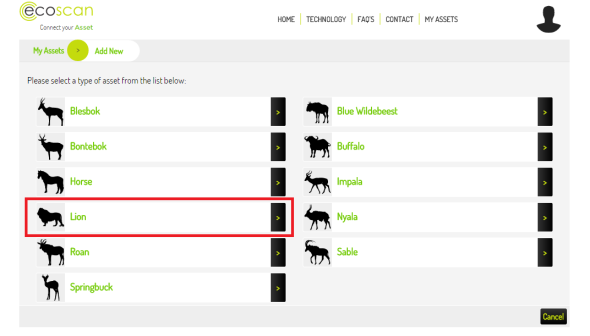 ECOSCAN is a system that Ukutula Lion and Research Center uses to sell animals on to buyers. Ukutula Lodge has also implemented into their terms and conditions one of the following rather interesting rules:
ECOSCAN is a system that Ukutula Lion and Research Center uses to sell animals on to buyers. Ukutula Lodge has also implemented into their terms and conditions one of the following rather interesting rules:
- Buyers must agree to the animal being chipped that both ECOscan and Ukutula Lodge monitor.
However what Ukutula Lion and Research Center do not tell you is that the buyer once they breed that Lion, them cubs are immune from this system. So after birth has taken place Ukutula Lodge has then distanced themselves from the questionable buyer. Meaning its “more than likely that hunting is occurring”. Lastly on checking with South African lawyers no buyer of any Lion from Ukutula does not under any circumstances have to agree with Ukutula’s terms of policies/agreements Etc. A very crafty move by an alleged Lion Research Center, one of which the public cannot easily trace that buyer too. Please view image below and click on the image to view which British Travel Agency supports it, alternatively please click >here<
Image: Volunteer Travel I-I UK supports Ukutula Lodge that Blood Lions called into question.
Last month the South African Non Governmental Organisation, Blood Lions called into question Ukutula Lodge that refused to allow the Blood Lions team onto their property to investigate claims in relation to canned hunting. To read more on that subject please view the link below:
http://www.bloodlions.org/us-volunteer-speaks-out-cubs-hired-for-parties-and-events-ukutula/
The last thing we ever wanted to be forced to do was to begin exposing the petting industry at an angle that sees us exposing those that directly contribute to the industry that has skyrocketed over the past ten years. Unfortunately we’re being forced too. We’ve provided more than enough facts, accounts, and evidence. What or more to the point how much more evidence do students, tourists and volunteers really require?
Image: Students at the Living with Big Cats Project.
Image: Student at the Living with Lions Project.
Image: Student at the Living with Lions Project.
Image: Student advertised on the UK Travel Firm Amanzi Travel UK.
Image: Lonely cub advertised for petting at the I to I Volunteering UK agency.
No money the public spends to pet or take photos with cubs ever goes to support conservation in the wild. In fact, the opposite is true. There is a huge and growing market for Tiger and Lion parts, and Tiger and Lion “derivatives”, i.e. products made out of Tiger and Lion parts like Tiger and Lion bone wine. A dead Tiger/Lion is worth up to $50,000 for its parts. Breeding what US Fish and Wildlife Service calls “generic” Tigers like the ones used in the mall exhibits is not tracked, similar to ECOscan system used by various lodges and parks in South Africa. So there is no way to know how many born Tigers/Lions are killed to have their parts illegally sold into this trade. And, the more that trade expands, the more incentive the poachers, hunters and farmers have to kill Tigers and other big cats in the wild and via hunting within South Africa. Yes sadly, farmers and lodges, parks and alleged “living with big cats programs’ will sell after hunting (in some if not all cases) bones on to the Asiatic market to double their money. All supported by you the volunteer, tourist and student.
RECAP:
The cubs used for petting exhibits/farms Etc are torn from their mothers shortly after birth, causing emotional pain to both the cubs and the mothers. Imagine what that mother experiences after enduring the long pregnancy and finally giving birth, filled with the instincts to nurture her cubs, and then having them snatched away. The breeders take them away and have people handle them so the cubs will “imprint” on the people instead of doing what is natural and imprinting on their mothers.
And what is life like during the months they are used to make money for their owners? Cubs this age want to roam, explore, test their young muscles to develop coordination, and sleep for extended periods of time without interruption. Watch what happens during these exhibits. The cubs are repeatedly awakened so a customer can pet them instead of being allowed the sleep their young bodies need. When they try to wander they are repeatedly yanked back. And where are they when not on exhibit? Well I’m sure you can answer that question. A nursery maybe? Possibly, without the mother that is pining for her young? Just because its a cozy looking nursery means nothing.
Thank you for reading.
Dr Jose C. Depre.
Chief Environmental Officer and CEO;
PhD. MEnvSc. BSc(Hons) Botany, PhD(NeuroSci) D.V.M. Environmental & Human Science
Environmental and Animal Rescue Investigations Chief Officer.
UKUTULA: TOURIST AND STUDENT BOYCOTT.
STUDENT AND TOURIST - BOYCOTT
International Animal Rescue Foundation Africa’s Board of Directors have decided to call for an immediate tourist and student boycott of Ukutula Lodge & Lion Park (Ukutula Lodge) situated at the address below with immediate effect. Please share this data onto all friends, family, work colleagues and, anyone that you know who’s planning on visiting the Ukutula Lodge & Lion Park (Ukutula Lodge) in South Africa:
Ukutula Lodge & Lion Park (Ukutula Lodge) please click the links below for GPS and Sites.
26 of the Farm Klipkop,
JQ411,
Brits, 0250,
South Africa
GPS UKUTULA LODGE AND LION PARK
We the organisation please encourage all members of the public to visit TRIP ADVISER and UKUTULA SOCIAL MEDIA pages and pre-warn all members of the public and provide a ONE STAR rating not to visit this lodge. This farm lodge has categorically lied to the public, are selling animals onto to hunt, and haven’t answered a single question put to them since 2013. Today 2015 after the lodge yet again tried to fool the public into airing “a recorded and cut version of the BLOODLIONS.ORG film showing what (they want to show) Blood Lions made the following statement.
We the [organisation] have thought long and hard in relation to issuing a boycott with regards to Ukutula and their unprofessional practices operating under the guise of species research. International Animal Rescue Foundation Africa has taken in to consideration all aspects of the boycott, the implications this boycott could have on captive breeding and monetary loss. However had there not been evidence that clearly shows trade of Lions and other animals to silent partners, organisations and farms then we’d have not called for a mandatory boycott. Vasts sums of monetary income are coming into this lodge from private buyers of Lions, Cheetahs, Tigers and other animals. The farm doesn’t require funding from foreign tourists that are being lied too, brainwashed and fed misinformation, therefore a boycott must commence to shut this practice down.
Tourists and students that visit the Ukutula Lodge and Lion Park travel from the following countries: Germany; France; Finland; Holland; Denmark; Belgium; Norway; Serbia; Romania; Sweden; United States; Canada; Italy; Australia; New Zealand; Czech Republic; South Africa; Namibia; Zimbabwe; Botswana; Ireland; Portugal; Greece; Thailand; China; Vietnam; Brazil; Peru; Argentina; Mexico; Hawaii; India and Taiwan. There are likely many other countries that tourists and students are encouraged to visit too. However the vast majority are coming in from Holland, Germany, France, United Kingdom, United States, South Africa and Belgium.
Further boycotts will be called for and all boycotts with data and contact details will be posted onto our main environmental news and media site. Boycott information will be communicated to our education and youth team, as well as being communicated to all 6.1 million supporters, 400,000 of which are aligned to our Africans organisation. Any organisation or company that is aligned to Ukutula and is either promoting their services, establishment, funding their team or is actively involved in pseudo education and conservation will also fall into the international boycott too.
Environmental News and Media have identified further third parties that are actively encouraging the promotion of UKUTULA Lion and Game Lodge too identified hereto: Pieter and Brenna, Hartbeespoort and the Crafters Market of which Your Cheetah Spot company are trading images of cubs and adults to the public. We suspect that these images and other crafts sold via the company through the market via felid exploitation are providing a source of income to both the company and Ukutula. This practice is unethical and encouraging the deaths of our wildlife. The University of Pretoria are also supporting the UKUTULA Lion and Game Lodge too. We please ask that international students refrain from visiting this university that are sponsoring the work of UKUTULA. Should we locate any further companies or teaching establishments that are promoting the UKUTULA lodge we’ll be implementing them within our daily news netter ebullition and hereto on this site.
This entire game lodge is not under any circumstances teaching practical or professional conservation. What they are doing is selling animals onto silent and unknown buyers, and promoting/encouraging petting. International Animal Rescue Foundation Africa will furthermore expose tourists, students and anyone that ignores our advice and that of third party NGO’s and investigative teams.. International Animal Rescue Foundation Africa’s role is to now shut this entire establishment down. Alternatively the establishment can immediately stop their pseudo practices and continue “professional conservation” while answering our questions.
WHY ARE WE CALLING FOR A TOURIST AND STUDENT BOYCOTT OF UKUTULA?
International Animal Rescue Foundation Africa are calling for boycotts for the reasons set out hereto:
1. Promotion and interaction of felid cubs. (petting)
2. Evidence that proves cats and other animals allegedly used for research that allegedly live their life out on the grounds, being sold to private and silent buyers, organisations and farms.
3. Evidence that proves the lodge is actively involved within the hunting industry be it directly or indirectly.
4. Failure to answer straightforward and polite questions in relation to the above from ourselves, leading big cat specialists, and third party conservation organisations.
This boycott will be communicated in French, Dutch, German and Spanish. Furthermore we encourage others to please translate to your fellow friends, family, work colleagues and students.
International Animal Rescue Foundation Africa will call this boycott off at anytime should we be provided with the following data.
1. How many cats from the felid family have you bred since founded?
2. How many cubs and other members of the felid family have you sold onto individual buyers, farmers, safaris, and reserves Etc. since founded?
3. To whom have you sold the above animals too under your terms for ECOSCAN? I.e. names of farms, safaris, game reserves, lodges, private hunting services, zoological gardens, individual buyers Etc?
4. Please provide any data to back your claims up that you do not support the slaughter of any animals on your farming lodge?
5. Please provide an explanation as to why you feel its necessary to remove cubs from their mothers when the mothers can rear them quite capably.
6. Are you prepared to allow independent environmental investigation officers to visit your lodge and undertake a TWO YEAR review of your scientific research, monitoring of all captive felids from the hours of 06:00am to 18:00hrs? Monday to Saturday?
7. Do you have any other land or holding facilities that are not mentioned within the public domain?
8. Are you connected to any hunting organisation, safari, reserve or other institution that promotes hunting or sustainable utilization.
STUDENT TOURIST ACCOUNT VIA BLOODLIONS.ORG
British wildlife volunteer, Keeton Hill, shares his experience and findings after his time at Ukutula farm, South Africa.
In 2013 I volunteered at Ukutula, a supposed lion conservation centre outside of Brits, Pretoria, in South Africa. For 6 months afterwards, I spoke of how great the experience was, and about how much good Ukutula were doing. Several weeks after returning from South Africa, I saw a claim that they were involved in the sale of lions for hunting. Initially, I dismissed this claim. However, after seeing more accusations, I decided to do some research to prove these claims wrong. A year and a half later, I am still yet to do so. Instead, I have only seen more and more evidence that I actually volunteered at a farm largely suspected to be involved in the canned hunting industry.
The project was booked through an agency which specialises in volunteering and working abroad. I spent 2 weeks in South Africa looking after lions. At Ukutula, volunteers were told that the lions were removed from their ‘dangerous’ parents, and hand-reared instead for their own safety. We were then told that samples were taken from the 100+ lions on the farm for research purposes, and that where possible, older lions were released into the wild.
During my two week stay, I noted several ways of doing things that I didn’t agree with. For example, there was no permanent staff member in charge of supervising the volunteers who were looking after the cubs. Upon arrival, volunteers were given a brief overview of how to care for them. As of that overview, it was up to the volunteers to decide between them who were to complete what tasks. Any authorisations or approvals were to be sought from the owners, who weren’t always available. This sometimes led to volunteers not knowing how to handle some situations, which then resulted in disagreements between volunteers. For example, some volunteers allowed young children to pet the cubs, whilst others didn’t. Some allowed guests to feed the cubs, others didn’t. There was also an occasion during which the powdered milk supply for the cubs ran out. It was a two hour wait before more was delivered. I also didn’t agree with the cubs being able to be hired for parties and events (which happened several times during my stay). Despite these things, I naively believed everything that we were told about the ‘research’ conducted at the park, and the lion ‘release’ program.
WOULD UKUTULA AND MR STRACHAN PLEASE BE KIND ENOUGH TO PROVE WHERE ALL OF THESE ANIMALS ARE NOW SHOT BY A STUDENT BACK IN 2013 IN THE VIDEO BELOW?
After the accusations against Ukutula were made, and I started my research, it became clear that these claims of releases were simply not true, and that Ukutula was far from what it made itself out to be. I realised that it operated in exactly the same way as canned hunting farms are described as operating. These similarities included a constant stream of cubs being born (there were 9 under the age of 3 months whilst I was there, with more on the way), large groups of tourists petting the cubs throughout the day, walks with older lions, and promises of the eventual release of lions into the wild (of which no evidence has ever been provided).
In order to build up a balanced and comprehensive picture about Ukutula, and find out as much about it as possible, I asked questions to a previous volunteer, a previous member of staff, and the centre’s current owner. I asked both the previous volunteer and previous staff member if they had any reason to believe that the suggestions regarding Ukutula being involved in the canned hunting industry were true. The volunteer told me that they no longer supported the centre, as they had heard several claims that lions were sold from the park (something which the centre themselves later admitted to). The staff member politely declined to comment. I then asked the current owner a series of questions, regarding why they bred so many lions, and when and where their lions are released. I was told that the centre had never claimed to release lions into the wild (which is simply not true, as myself and several other volunteers were told by the centre themselves that they do).
Since this initial realisation, it has only become more and more clear that the Ukutula lies to its volunteers and guests, has never released any lions into the wild, and that they are also more than likely involved in canned hunting. The farm admitted to moving at least 2 lions, Michael and Mandela, to zoos in the United States, and the whereabouts of several lions, such as Kevin, Kylie, Ricky, and Jenny, to name just a few, are now unknown. Attempts at finding out where these lions might be through asking members of the farms staff have proved unsuccessful, always resulting in rudely written replies, which avoid answering the question. For example, when asked the whereabouts of Kevin the lion, an Ukutula employee replied, “none of you(r) damn business”.
When I questioned the farm using an alternative email address to my own, posing as a volunteer interested in working there, they admitted that “lions are relocated in different places”. When I asked, “doesn’t that mean that the people that you send lions to could then sell them onto hunters”, the farm replied that, with a supposed “monitoring system” in the planning, this should mean that they should be “able to react to that”, but “sadly it does not mean there is a 100% guarantee”. I have also since realised that the CITES database shows absolutely no record of any lions being exported from South Africa for release into the wild in any other country. However, what it does show, is mass exports for lion trophies, lion bones, and lion skin.
I have shared my findings and opinions with any volunteers who were at Ukutula with me, and continue to attempt to inform other people who have been to the farm, as well as people that I know personally, about the canned hunting industry. Unfortunately, many previous volunteers refuse to believe about the industry, and defend the farm, often insulting or ignoring the people trying to inform them.
As the canned hunting industry is entirely legal in South Africa, creating awareness and understanding of the industry is vital, as this is one of the only ways to fight against it. The more people who know about canned hunting, the better, as this lessens the amount of unknowing volunteers who believe themselves to be doing good, which then lessens the money that these farms receive. This is why Blood Lions is so important, as it could finally be the large scale exposure of canned hunting that is needed to educate people about the canned hunting industry, as well as maybe even changing the terrible fate of South Africa’s captive-bred lions.
END OF TESTIMONY
One of the most upsetting images is that from 2013 that depicts famous singer Kylie Minouge (pictured below) petting a Cheetah cub at Ukutula that has been removed from its mother (hardly a good example to set to our children or young wildlife conservationists). Many of the students whom travel to work at this Lion and farm lodge are often told that cubs have to be separated from their mothers as the mothers are “allegedly to dangerous” and could attack or do attack the cubs.
This seemingly irresponsible advice comes from a wide range of fake conservationists that work at the facility. One in particular Mr Alan Strachan whom runs the company “Your Cheetah Spot“. Scottish born Mr Strachan that works at the Ukutula Lion and Game Lodge actively encourages people to interact with Cheetah cubs, has been witnessed man-handling the Cheetah cubs, and provides the same excuses as most staff. “The cubs are ill, cannot be released into the wild or are suffering from a wide range of tendon or ligament problems (hence why they can all walk) and look (more than healthy).
If your still thinking on visiting and taking part in the petting of cubs of which you have been told these animals are introduced into the wild. Then ask yourselves this. Why are these animals in the video below that are allegedly “so dangerous” being hand fed, and are more than tame? But more importantly can Ukutula provide evidence to back their claims up that these animals in the video below and depictions above are not dead, or ANY of the females that are sold then bred producing cubs thus not falling under “Ukutula’s ECOSCAN policy” are not then killed for the canned hunting and the trophy hunting industry? Many hunters will try and tell you that this unethical practice is helping to increase populations of Lions. So in that case please do visit the IUCN Red List and look up the Panthera Leo, can you see anywhere in this data that proves such activities are helping Lions or any cat population increases in the wild? OPEN YOUR EYES!
“DON’T BE FOOLED BY CUTENESS OR FOBBED OFF WITH EXCUSES”
Dr Jose C. Depre
Chief Environmental and Botanical Officer.
Chief Executive Officer.
Contributing to Extinction: The Petting Scam.
THE BIG CAT DEBATE PART III
“Conservation is not Petting Cubs or Promoting the Petting Industry”
Over the past week and a half we have been investigating some nine conservation organisations and companies aligned to them organisations within South Africa. As of yesterday we began to make public them questions which were legitimate and fully above board. We have given two related companies known as Your Cheetah Spot and Ukutula Game Lodge over twenty four hours to answer the questions set out here on Facebook within this article. Any professional organisation that isn’t involved within the direct petting or game hunting of threatened species one would then think such questions would quite easily be answerable to place public faith into the domain. Unfortunately within the past hour it seems otherwise.
Your Cheetah Spot a photography and alleged merchandise company, and what appears to be an organisation that is directly aligned with the promotion of petting cubs has not only failed to answer more than straightforward questions, but has evaded them by attacking us with silly nonsense seen hereto. Now we weren’t pointing fingers, nor was we accusing which can be read in all of our posts on Facebook hereto.
While we respect that Your Cheetah Spot is indeed a company their main Facebook imagery and online articles states otherwise. In the image below one can clearly see that the Your Cheetah Spot company is in someway aligned with the recently brought into question Ukutula Game Lodge, that appears to have some two or more Facebook pages online. International Animal Rescue Foundation Africa is a company and not charitable. Meaning that we work for our money. From 2012 to 2015 we have become increasingly suspicions in relation to over ninety South African organisations being “conservation and hunting”.
We equated that over R8.9 BILLION (ZAR) has been pumped into all of the ninety hunting and conservation organisations. However we’ve seen little if any conservation work, reduction in species threat status, reduction in anti poaching or increase of any species they are directly working with in the wild. As we are not a charity but indeed a giver 1/2 of these organisations fell within our (Funding African and Asian Wildlife Survival) program. While we have not provided monetary income to Your Cheetah Spot or Ukutula Game Lodge, we have directly and indirectly promoted their services or organisation[s] (2013-2014). That in turn has technically brought our company into disrepute in regards to malpractice and public misinformation, furthermore it was somewhat more embarrassing that members of the public also pointed this out to us too, and not forgetting some twelve key conservation experts.
The image below shows that both Your Cheetah Spot and Ukutula Game Lodge are related in one way or the other.
Ukutula Lodge does go under other names of Facebook too such as Ukutula Game Lodge Etc. On viewing Your Cheetah Spot company we were somewhat concerned with the vast amount of small cubs that are in our eyes being petted by the public, or by the staff in general from which we believe is at the Ukutula Game Lodge. Please view the images below. Please also note that it has been alleged that some of these animals are “sick and unwell” and cannot be released into the wild. We our now bringing that into question.
The male in the image above is known as a wildlife photographer and conservation researcher, of which he also with his students, friends and family helps at the Cheetah Research Center, while meeting up with members of the public at the Ukutula Game Lodge or Ukutula Lodge. When putting questions to Scottish born Alan Strachan and the user on the Your Cheetah Spot Facebook page we was then made aware of the current unprofessional behavior of Ukutula Game Lodge. Its at this very lodge that our suspicions have yet again arisen, of which you can view in the images below.
Interestingly when viewing more data on Ukutula Game Lodge we were somewhat perplexed as to how many big cats this farm is currently holding of which it states “is research”. Even more worrying is that the vast majority of these cats are/or were all cubs, all of which are being bred on a “game farm”. Please view the data below.
Now just to remind the millions of readers that tune into our environmental investigations news site what a game farm is, we have made it very simple to read and understand for you to come to your own conclusions. Please see the image below.
A further suspicion that was then immediately raised by the External Affairs investigative team was the vast majority of friends on Mr Strachan’s Facebook friends list that are all (holding or petting) cubs, yet there seems to be no mothers in sight, please see the image below.
The list is pretty endless of which you can view more here
Any good professional conservation teacher, conservation organisation, research center, or reserve would not under any circumstances allow the direct petting of any big cat cubs. The potential for virus and disease to emerge and not forgetting the removal of the cats natural hunting instincts would severely be detrimental to the animals health. So on viewing the two parties being that The Ukutula Game Lodge and Your Cheetah Spot company that boasts years of experience then why are we seeing such behavior? Furthermore on questioning Your Cheetah Spot company they categorically stated that they hadn’t released any animals in to wild since [2007]. Yet they also stated to the CEO that they were just a simple photography and gift company.
International Animal Rescue Foundation Africa asked some nine very basic and straight forward easy to answer questions. The organisation has waited and waited, the questions were stern but not abusive. However it would appear that on asking such straightforward questions “Your Cheetah Spot company” has not only become abusive but have shown just how hateful of homosexuals they are (again clutching at straws and trying to turn the table onto us). See the screen shots below.
So when basic very polite questions are asked not only are we spat at with trolling nonsense from hunters and deluded pseudo activists whom have created these articles in the image above, the Chief Executive Officer is then spat more abuse at insinuating that he is gay and obviously goes under many other names too. And as yet, still there is no answers to our questions.
Linda whom runs the Facebook page Your Cheetah Spot stated that the vast majority of these animals cannot be released back into the wild. The kind lady also stated that many animals are sick or injured. Furthermore Linda stated that there is not enough room to simply release Cheetahs back into the wild within South Africa. As a more than competent and professional environmental company there is room, and there are also many active reintroduction programs over the border. In our own opinion these animals are not being released as then that would mean a loss of revenue. Furthermore if these animals are being bred for science, what happens to them after the research is up. Lastly as you may all remember Cecil? Cecil was one of many Lions that the Oxford University Lion Research Center studied, oddly IN THE WILD!
Reintroduction programs have been very operational within Swaziland for some years. Furthermore South Africa is not detached from the continent. Bordering you have Botswana, Namibia, Zimbabwe, Mozambique and finally Lesotho with Swaziland in the far right. So the excuse that these “many small cubs” that are new born and are most certainly not sick, old, injured (in most cases) cannot be reared in accordance to a professional captive breeding program is utter nonsense. Just to remind you - Linda whom is aligned with the You Cheetah Spot company stated that the last release was back in 2007 of any Cheetahs which we do believe was in the KWN.
A further concern is that Linda stated Alan Strachan (experienced photographer and author) has many contacts within the Cheetah Breeding theater, see image below.
The comment above is just a contradiction of what is being viewed at the Ukutula Game Lodge of which Alan Strachan visits regularly such as “you have to make sure that there is very little contact with humans” “The last prey release was back in 2007”. If these contradictions do not spring up red flags to you then they should. Swaziland has been the center for many Cheetah releases over the years as listed on the International Union for the Conservation of Nature’s website. Furthermore the sheer fact that in the vast majority of Mr Strachan’s images on his Facebook profile that depict “cub petting” and on their very own Facebook page is also somewhat concerning.
THE LIES BREEDING AND RESEARCH CENTERS TELL YOU
Below is a list of common lies or misinformation breeding, research and farming centers will try their utmost best to tell you. However at the end of the day its down to you to undertake your own research. Why are there so many cubs, why have there never been any releases of animals into the wild, why are there never no mothers seen with the cubs, why did the breeder or the supporter of a breeder state that these animals cannot be released back into the wild in South Africa..The simple answer to that question would be (mass loss of profit). Again we’re not putting words into your mouths, we are though asking you to please open your eyes, question, look around.
Breeders who charge the public to pet and take photos with young tiger, lion, cheetah or leopard cubs tell venues and customers some or all of the following ‘misinformation which is’:
1) That the exhibitors are “rescuers” and operate “sanctuaries”
2) That the cubs have a good life while being used to make money:
a) They enjoy being carted around the country in a semi and repeatedly awakened and handled by dozens of people all day
b) That blowing in the cubs face “calms” them down
c) That dangling them by holding under their front arms and bouncing them up and down “resets” them cubs at the mall
Cubs at the mall always = cub abuse
d) That close up photos with flash does not harm the cubs
3) That it is safe for the cubs and for humans, and legal, to allow contact with cubs from when they are only a few weeks old to when they are six months or more old.
4) That the exhibitor must keep constantly breeding and using the cubs to make money because that is the only way he can support the adult animals he keeps.
5) That the exhibitor is doing this to promote conservation in the wild.
6) That the exhibitor is teaching people not to have exotic animals as pets
And the biggest lie of all:
7) That the cubs will have good homes after they get too big to be used to make money from petting.
The images and evidence that is seen on one of the nine alleged conservation organisations that are either directly or indirectly involved in the promoting of petting or in this case “science and research”. Have shown little evidence of anyone of these animals actually being released into their native wild.
We DO NOT buy the excuse that states there is little room in South Africa to release these animals back into their native wild. Africa is a continent and South Africa is most certainly not detached from neighboring countries. South Africa borders Botswana, Namibia, Zimbabwe, Mozambique, Lesotho and Swaziland. Swaziland is one country of particular interest as many Cheetah reintroduction programs are happening within this country. The Cheetah Spot company also made public that Mr Strachen has many contacts with “Cheetah breeders” so why are we not seeing reintroduction, but more ‘petting’ of which these images are directly promoting the petting industry which in turn directly promotes the canned and non-canned hunting industry.
If you would like to know more about felid petting one can view the link here supplied by the Big Cat Rescue.
So as our questions haven’t been answered then we’ll reprint them here in a more orderly and professional fashion. On hitting the publish button the news letter will be sent to over 2,000 subscribers and over 6.1 million supporters respectfully.
- What relation does Mr Strachan and Your Cheetah Spot company have in relation to the Ukutala Game Lodge?
- Why are there so many cubs being shown on the Ukutala Game Lodge and Your Cheetah Spot company that are not unwell but more than healthy?
- Why are there so many cubs with no mothers being petted at the Ukutala Game Lodge, and where are their mothers?
- What happens to the cubs being shown on the Your Cheetah Spot company and Ukutala Lodge when you have reached maximum holding capacity?
- From reading, Your Cheetah Spot company states its nothing more than a photography and merchandise company. The company stated that they have only managed to release some Cheetahs into the wild back in 2007. So from 2007 to date you’ve obviously been in contact with more cubs, so how many animals are you holding on this farm, and where are the excess going too, one cannot just continue breeding and not releasing they are obviously going somewhere?
- Are you Ukutula and Your Cheetah Spot company involved in game or canned hunting?
- Why are you “Your Cheetah Spot” company directly encouraging through photography the petting industry but then contradict yourselves by stating that these animals must have the bare minimal human contact?
- Are both Your Cheetah Spot company and Ukutala Game Lodge aware of the health implications to these animals via the direct handling, man-handling and petting of cubs and elders?
- Why does the Your Cheetah Spot company that stated 1. They are just a merchandise company then 2. agreed they are working directly with these animals believe that South Africa is the only country that these animals can be released into?
- Will you Your Cheetah Spot company and Ukutula Game Lodge make public the amount of animals that you have allegedly helped, released into the wild and how many have been deliberately bred?
- Why when questioned did you not answer the questions highlighted but then some 14 hours later placed untrue, derogatory and misleading data into the public domain asking people to share. When all we did was obtain the information from your own sites, your own staff, friends and online data? No professional organisation or individual would behave in that manner?
- How much money are Your Cheetah Spot Company directly making from petting big cats and cubs?
- How much money are Ukutala Game Lodge making from the direct petting of big cats and cubs, and where is this money going too. Why are you also promoting the “interaction with very healthy cubs” to foreign tourists of which is commonly known as a “Lion Petting Farm aka Hunting Industry”?
The next time you want to abuse us you may want to remember that we are not propagating misleading lies about you. The data above has derived directly from you. All we have done is placed that all together, reviewed it and come to the conclusion that from questions 1-13 both of you are in some way directly involved in the petting industry which has direct relations to the hunting industry.
For now we’re going to leave our concerns at this. We will though be going through all organisations and individuals aligned with us and, if found to be exploitation any animals will be removed and exposed by us. Lastly when you have emigrated to our country please respect our natural heritage.
External Affairs Department
externalaffairs@international-animalrescue-foundation.org.uk
Environmental and Animal Abuse Investigations Authority Europa.
EXTERNAL AFFAIRS HEAD OFFICERS:
Jose C. Depre: Chief Executive Officer.
Johan Le roux: Anti Poaching / Illegal Animal Parts Trade Head Investigator.
Michal Jooste: Endangered Species Watch.
Pitier Van rens den: Chief Environmental Officer and Emergency Rescue.
Endangered Species Friday: Aceros nipalensis
Endangered Species Friday: Aceros nipalensis
This Fridays (ESP) - Endangered Species watch Post I have chosen to document on this stunning species known commonly as the Rufous-cheeked Hornbill, because of large population declines throughout most of the birds historical range. More awareness needs to be created with regards to this particular bird specie due to their natural habitat declining and localized extinctions that have already occurred in the past decade. Furthermore extinctions are now likely to occur within Viet Nam and [west] Thiland where hunting is the primary threat to the species.. (Image credit Ian Fulton).
Identified back in 1829 by Mr Brian Houghton Hodgson (1 February 1800 or more likely 1801– 23 May 1894) was a pioneer naturalist and ethnologist working in India and Nepal where he was a British Resident. He described numerous species of birds and mammals from the Himalayas, and several birds were named after him by others such as Edward Blyth.
Listed as vulnerable the A. nipalensis is endemic to Bhutan; China; India; Lao People’s Democratic Republic; Myanmar; Thailand and Viet Nam. Unfortunately A. nipalensis has already been declared extinct locally in Nepal. Like many large birds within this region of Asia the Rufous-cheeked (or necked) Hornbill’s populations are declining quite extensively throughout their range of which deforestation and habitat degradation and, hunting is primarily to blame.
The species has been listed on Cites Appendix (I-II) of which an estimated population census count has determined there are no less than 2,500 birds but no greater than 9,999. A survey count back in 2001 by Bird-Life International concluded that from the [estimate] above the [true] population count is actually by far more lower than previously suggested, however few conservationists are now debating this due to the birds ‘alleged’ extensive range within South East Asia.
From the Bird Life International (2001) census the organisation stated there was no fewer than 1,667 mature individuals but no greater than 6,666, which is rounded to 1,500 to 7,000 mature individuals exactly. Since the last 2001 census its quite possible populations have increased and decreased to date.
A. nipalensis is known to inhabit the following ranges; Bhutan, north-east India, Myanmar, southern Yunnan and south-east Tibet, China, [west] Thailand, Laos and Viet Nam. The species has declined [drastically] and is no longer common throughout most of its known historical range. While we know the species is now regionally extinct within Nepal the next likely localized extinction may very well be within Viet Nam of which its populations have fallen to alarming rates.
Within [most] of Thailand where the species was quite common reports have sadly indicated the bird is no longer commonly seen, and like Viet Nam, Thailand could become the third county to see localized extinctions occurring too, the only known habitat within Thailand that A nipalensis occurs now is within west Thailand. To date reports have confirmed that within Bhutan A. nipalensis remains pretty much common of which Bhutan is known to the birds [largest] stronghold.
Healthy large populations have also been documented back in 2007 within Namdapha National Park, India, Nakai-Nam Theun National Biodiversity Conservation Area, central Laos and perhaps also Huai Kha Khaeng, [west Thailand], and Xishuangbanna Nature Reserve, China. Some conservationists have been led to believe that while populations are considered quite large within these strongholds that the species may very well be “more widespread than previously thought”. Meanwhile the species is known to inhabit north Myanmar, and there are recent records from West Bengal and Eaglenest Wildlife Sanctuary, Arunachal Pradesh, India.
Rufous-cheeked Hornbill commonly resides within broad-leaved forest, some reports have also indicated the species to be present within dry woodland too. Mating and nesting normally occurs from the months of March to June within large wide girth trees, the very trees that the species depends on though are being felled throughout most of the Hornbills historical range.
Image: Rufous-necked-Hornbill (Photographer unknown)
Major Threats
Its dependence on large trees for feeding and nesting makes it especially susceptible to deforestation and habitat degradation through logging, shifting cultivation and clearance for agriculture. Furthermore, viable populations require vast tracts of forest to survive, exacerbating its susceptibility to habitat fragmentation. These problems are compounded by widespread hunting and trapping for food, and trade in pets and casques. Hunting is the primary threat to the species in Arunachal, India. A report from the Wildlife Extra organisation details poaching incidents with regards to Hornbills.
Wildlife Extra stated:
The unique and intriguing breeding habits that caught Pilai Poonswad attention are central to the birds’ plight. Each hornbill pair seeks out a suitable hollow – 15 to 40 metres above the ground in the trunk or branch of a Neobalanocarpus, Dipterocarpus or Syzygium tree – in which to raise a single chick. When a suitable cavity is found, the female walls herself in, using mud supplied by her mate and regurgitated food, to hatch and rear her chick. The male feeds them for the next three months and, if he fails, both mother and chick may perish. The birds consume up to 80 different kinds of fruit, scattering the seeds over many hectares of forest. With other seed-distributing animals such as monkeys now scarce, the hornbill has become pivotal in maintaining the integrity of the forest. But the birds rarely spread the seeds of the trees in which they nest: if these disappear, the hornbills too will vanish – and the trees and plants they help propagate will soon follow.
Click the link above via the [report] to read more on this very fascinating conservationist.
My name is Dr Jose Carlos Depre, MD, B.Env.Sc, BSBio, D.V.M. I myself have been working within bird, tree kangaroo and pachydermata conservation, rescue and reporting for over fifteen years.
Within these unique, wonderful and exhilarating years I have witnessed one of my favorite species of animals [birds] declining to worrying levels that is now so concerning it has led to sleepless nights for many years. Should we continue to see such catastrophic population decreases of birds we’ll eventually witness alarming declines of plants and trees. The same applies with insects and herbivorous mammals too.
Like insects birds are incredibly important for both human and animal survival. The vast majority of all bird species rely on plants for their staple diet. On consuming fruits, leaves, flowers Etc, the very seeds within the birds diet of life needed to continue seed dispersal will be lost should all bird populations go extinct. Should this occur we selfish humans will then become the Planets seed disperses. Think about that next time you fell a tree or rip a plant up.
Dr Jose. C. Depre
Environmental and Botanical Scientist.
Thank you for reading and please share fare and wide to create as much awareness for all Hornbills as possible.
Endangered Species Monday: Phalacrocorax carunculatus.
Endangered Species Monday: Phalacrocorax carunculatus
This Mondays (ESP) Endangered Species watch Post is dedicated to the Rough Faced Shag, scientifically known as Phalacrocorax carunculatus. Identified back in 1789 by Professor Johann Friedrich Gmelin (8 August 1748 – 1 November 1804) was a German naturalist, botanist, entomologist, herpetologist and malacologist. (Image credited: Jim Scarff 2010)
Listed as (vulnerable) the Rough Faced Shag doesn’t appear to be listed on either appendix (I) or (II). This Monday I have chosen to document on P. carunculatus as the species is incredibly rare. Thankfully conservation efforts and improvements in relation to protection of habitat have finally stabilized the birds population count. For once in many of my articles I can finally write on a bird that’s populations are not in decline. However, as explained the species is considered one of New Zealand’s rarest specimens.
Endemic to New Zealand the species derives from the family of Phalacrocoracidae. Locals commonly refer to the species by other names such as; New Zealand King Shag or King Shag. P. carunculatus qualified for the listing of vulnerable due to its very small (stable) population size where its restricted to four islands only.
From 1992 to 2002 the estimated number of birds living on all four islands stood at a mere c645 individuals (Est). A further 100-130 breeding pairs were counted too, which is equates (roughly) to 299-1000 ‘mature individuals’. Taking all individuals and breeding pairs into consideration followed up with the last census, it concluded that some 375- 1500 individuals remain on all four islands. Had drastic conservation measures not been implemented the species could have gone extinct.
Conservation practices on all four islands have been undertaken extremely well despite the fact populations are depressed. I personally applaud the New Zealand Government and Department of Environment for their efforts, and thank them for continuing future conservation and bird management projects.
Image: Rough Faced Shag small colony.
92% of the population resides on White Rocks, Sentinel Rock, Duffers Reef and Trio Islands, in the Marlborough Sounds, with two smaller colonies off D’Urville Island. Furthermore surveys on islands have confirmed that populations have remained stable over the last fifty years.
Breeding normally occurs on small rock stacks and islets, the primary diet component is said to be left eyes flatfish. However the Rough Faced Shag will also feed on other marine aquatic specimens too.
Colonies now reside within wildlife sanctuaries that are clearly signposted on the islands reminding tourists and any wannabe poachers to stay clear of Rough Faced Shag habitat. Bird watchers are also reminded to stay clear of habitat, especially when breeding occurs due to the species being very sensitive to human disturbance. I am somewhat concerned as to how a tourist has been able to edge so close the colony within the image above. This isn’t good and as such enforcement teams must remind tour operators of the (code of conduct).
Conservation actions that are now underway include a census count every five years and, monitoring of vessels that can/do cause habitat disturbance. Furthermore development of techniques to establish new colonies of Rough Faced Shags elsewhere for future survival. A code of conduct has been established to (remind commercial boats, fishing-people and tour operators) of their obligations and duties to ensure Rough Faced Shags are not pressurized by human disturbance.
Protection of all breeding grounds has most likely been sought since last documentation on the species (2012). Prevention of marine farming next to ‘any’ colonies breeding or non-breeding and responsible fishing programs have been rolled out minimize by-catch thus ensuring the birds food source requirements are not depleted or harmed in anyway.
Threats
In the 1800s, collecting by ornithologists and hunting for the fashion trade may have affected numbers. Human disturbance (boats, aircraft and scuba divers) can cause desertion of nests and subsequent predation by gulls. New interest from tour operators in the region may increase the problem. Set-nets are sometimes placed very close to colonies and present a major risk. Birds are occasionally illegally shot. Probably the largest threat now is that of tourists or fishermen disturbing breeding and non-breeding colonies. Hence why conservation measures have been put into practice to remind and keep tourists and fisherman away from all inhabitant islands.
Thank you for reading.
Dr Jose C. Depre
Environmental and Botanical Scientist.
Endangered Species Monday: Pseudalopex fulvipes.
Endangered Species Monday - Pseudalopex fulvipes
In this Monday’s endangered species article we focus our attention on the species of fox commonly known as the Darwin fox. Identified by Dr William Charles Linnaeus Martin (1798 - 1864). Dr Martin was an English naturalist.William Charles Linnaeus Martin was the son of William Martin who had published early color books on the fossils of Derbyshire, and who named his son Linnaeus in honor of his interest in the classification of living things.
Listed as CRITICALLY ENDANGERED the species was scientifically identified as Pseudalopex fulvipes endemic to Chile, Los Lagos. Charles Darwin collected the very first evidence of this rather stunning species back in 1834 however was not the primary identifier despite the species name. Since 1989 the fox has been re-monitored to determine its current population sizes and future classification. I am somewhat skeptical that this species will survive into the next five years even with more in-depth wild analysis - the species in my own expert opinion is doomed.
One fox was observed and captured back in 1999 for data and breeding with a further two adults captured back in 2002 in Tepuhueico. That same year it was noted a local as killing a mother and her cubs which amassed to some four Darwin foxes witnessed dead and alive within the wild since revaluation of species began from 1989. Some evidence although (little documented) has confirmed “sightings” of Darwin foxes during the year of 2002 however, these are sketchy reports.
On mainland Chile, Jaime Jiménez has observed a small population since 1975 in Nahuelbuta National Park; this population was first reported to science in the early 1990s. It appears that Darwin’s Foxes are restricted to the park and the native forest surrounding the park. This park, only 68.3 km² in size, is a small habitat island of highland forest surrounded by degraded farmlands and plantations of exotic trees. This population is located about 600 km north of the island population and, to date, no other populations have been found in the remaining forest in between.
Darwin’s Fox was reported to be scarce and restricted to the southern end of Chiloé Island. The comparison of such older accounts (reporting the scarcity of Darwin’s fox), with recent repeated observations, conveys the impression that the Darwin’s Fox has increased in abundance, although this might simply be a sampling bias.
As explained even with a very, very small increase in sightings - populations are declining and sadly we may be reporting in the next year or two an (extinction in the wild) occurring if not a complete extinction overall. Should that happen we’ve lost the entire species for good.
Darwin foxes are said and known to be forest dwelling mammals which could be why environmental surveys are proving to be fruitless. Darwin foxes occur only in southern temperate rainforests. Recent research on Chiloé, based on trapping and telemetry data on a disturbance gradient, indicates that, in decreasing order, foxes use old-growth forest followed by secondary forest followed by pastures and openings. Although variable among individuals, about 70% of their home ranges comprised old-growth forest.
Protected under Chilean law since 1929 the Darwin fox are listed on Cites Appendix II (Convention on International Trade of Endangered Species wild flora and fauna). Conservation actions that are under way in the Nahuelbuta National Park are to increase species populations and establish overall protection within this range. Temuco zoo did hold one single species of which was believed to be held for protective captive breeding however the fox has since died back in 2000.
Threats
Although the species is protected in Nahuelbuta National Park, substantial mortality sources exist when foxes move to lower, unprotected private areas in search of milder conditions during the winter. Some foxes even breed in these areas. This is one of the reasons why it is recommended that this park be expanded to secure buffer areas for the foxes that use these unprotected ranges.
The presence of dogs in the park may be the greatest conservation threat in the form of potential vectors of disease or direct attack. There is a common practice to have unleashed dogs both on Chiloé and in Nahuelbuta; these have been caught within foxes’ ranges in the forest. Although dogs are prohibited in the national park, visitors are often allowed in with their dogs that are then let loose in the park.
There has been one documented account of a visitor’s dog attacking a female fox while she was nursing her two pups. In addition, local dogs from the surrounding farms are often brought in by their owners in search of their cattle or while gathering Araucaria seeds in the autumn. Park rangers even maintain dogs within the park, and the park administrator’s dog killed a guiña in the park. Being relatively naive towards people and their dogs is seen as non-adaptive behaviour in this species’ interactions with humans.
The island population appears to be relatively safe by being protected in Chiloé National Park. This 430 km² protected area encompasses most of the still untouched rainforest of the island. Although the park appears to have a sizable fox population, foxes also live in the surrounding areas, where substantial forest cover remains. These latter areas are vulnerable and continuously subjected to logging, forest fragmentation, and poaching by locals. In addition, being naive towards people places the foxes at risk when in contact with humans. If current relaxed attitudes continue in Nahuelbuta National Park, Chiloé National Park may be the only long-term safe area for the Darwin’s Fox.
No commercial use. However, captive animals have been kept illegally as pets on Chiloé Island.
Current estimates place the species population count at a mere 250 left within the wild.
Thank you for reading.
Please share and lets get this fox the protection it requires through education, awareness and funding.
Links for interest:
Dr Jose C. Depre.
International Animal Rescue Foundation Africa.
info@international-animalrescue-foundation.org.uk
International Animal Rescue Foundation Africa.
Donate to Say No To Dog Meat today.

